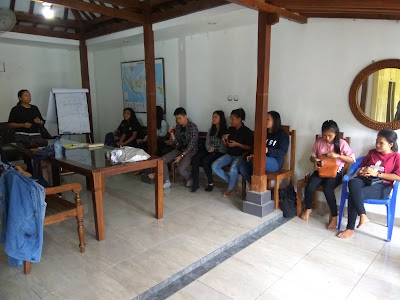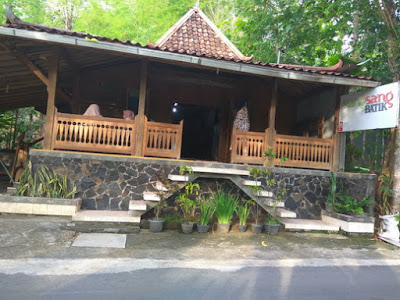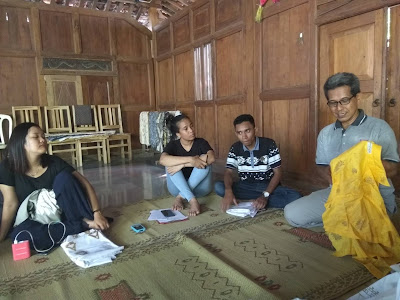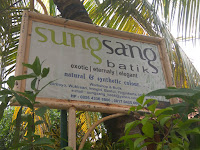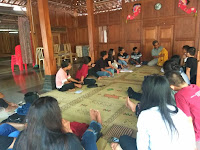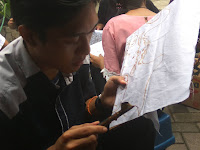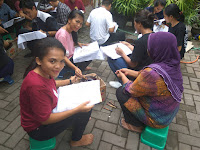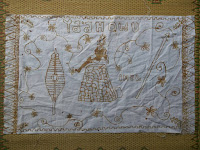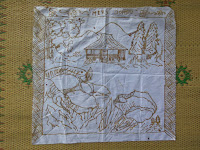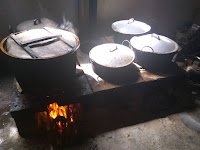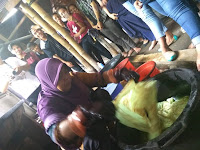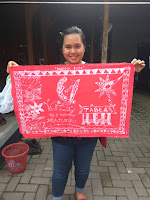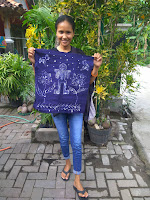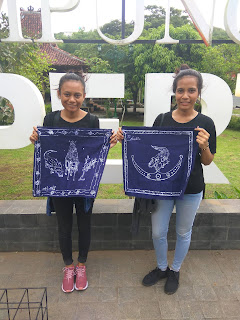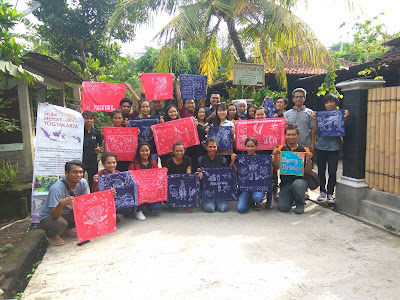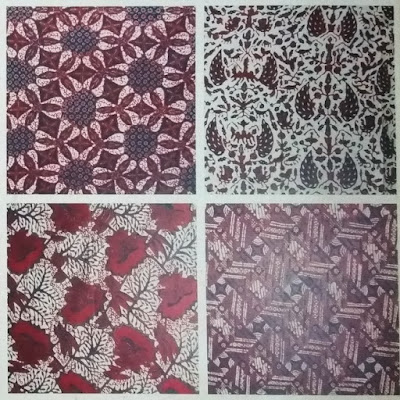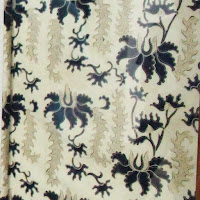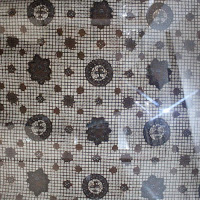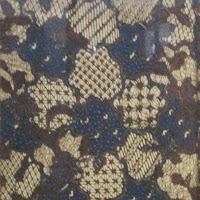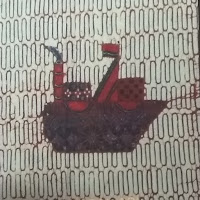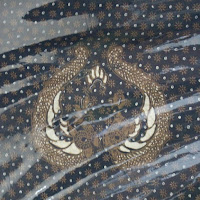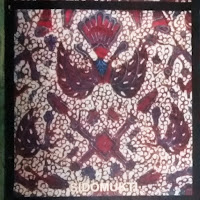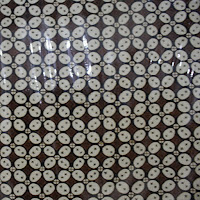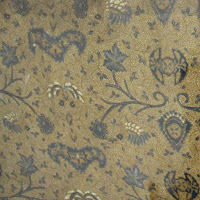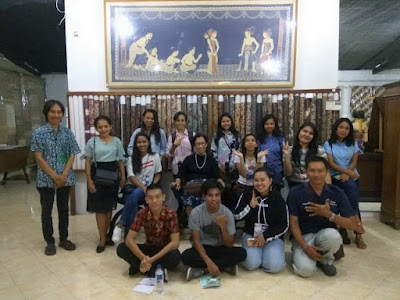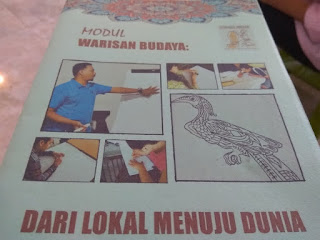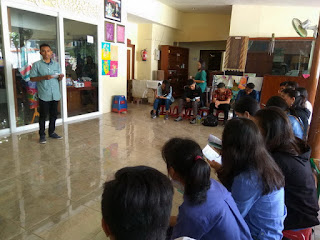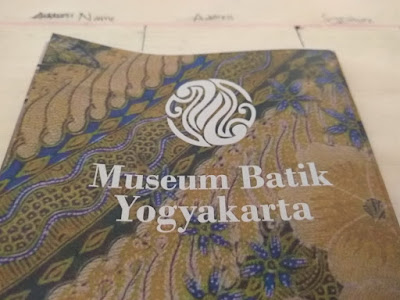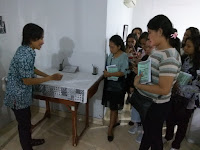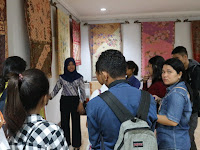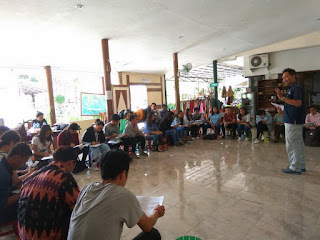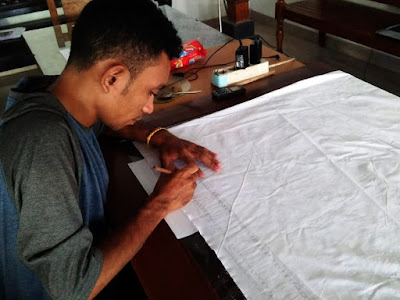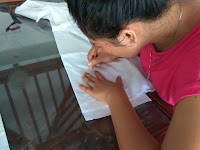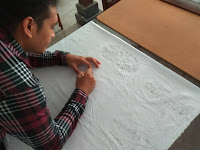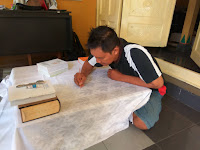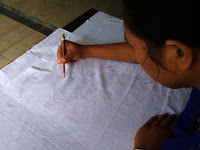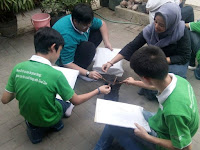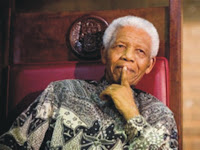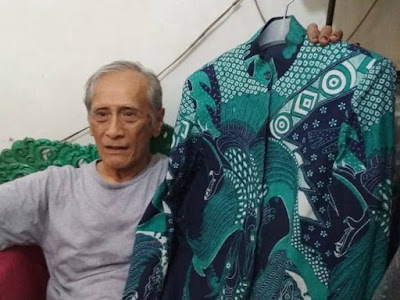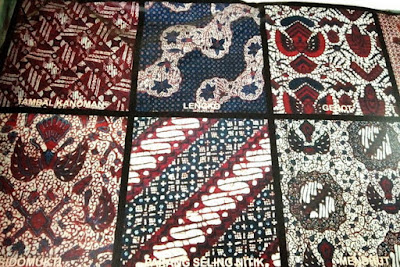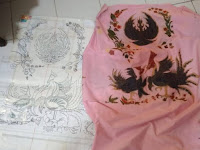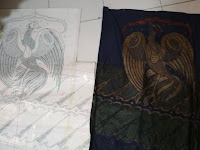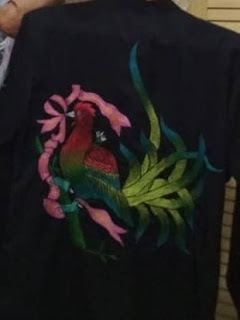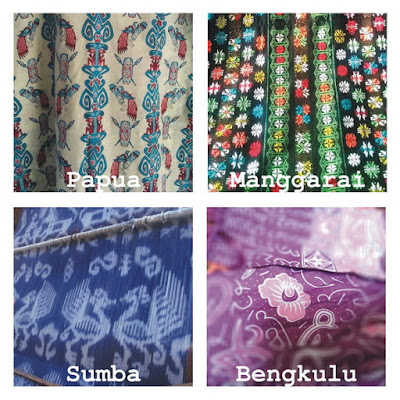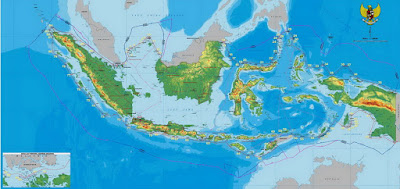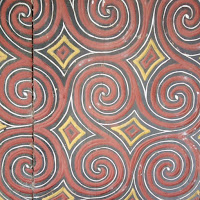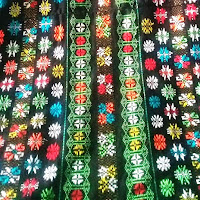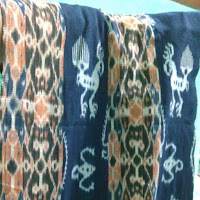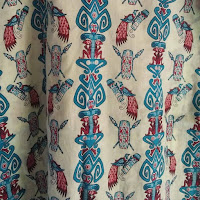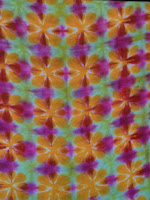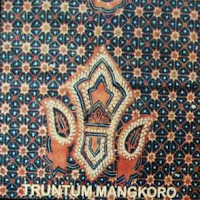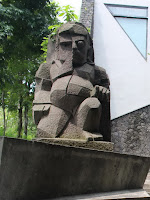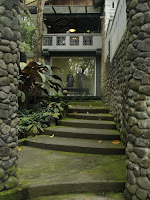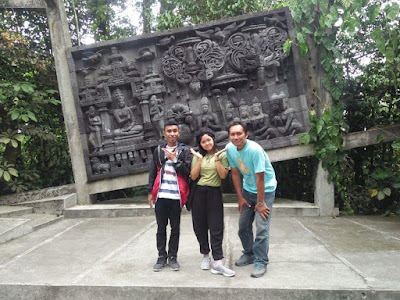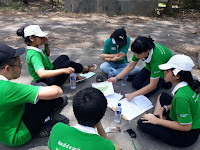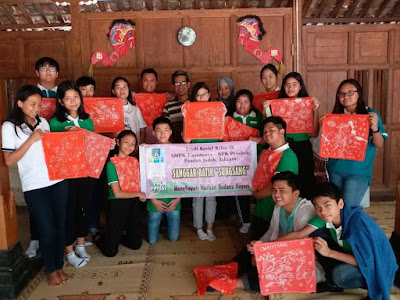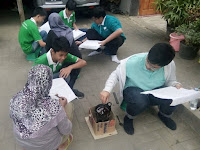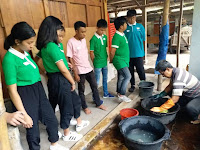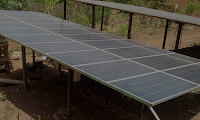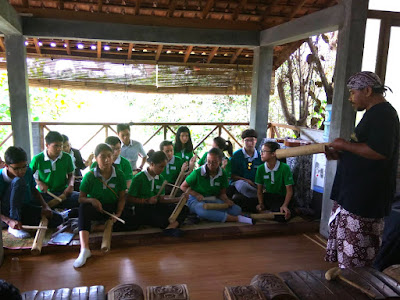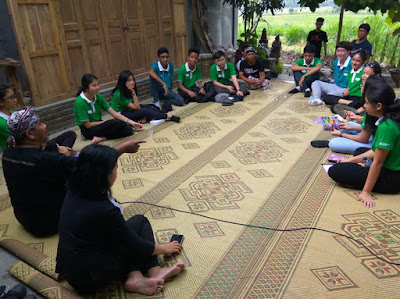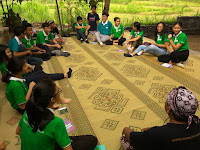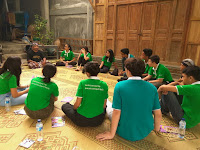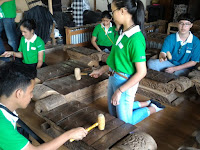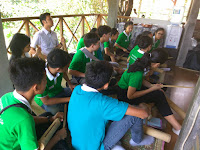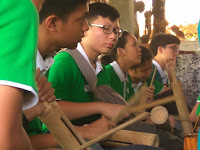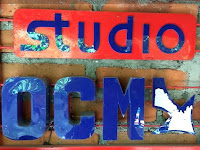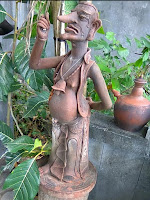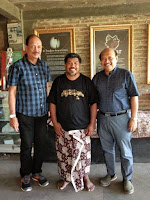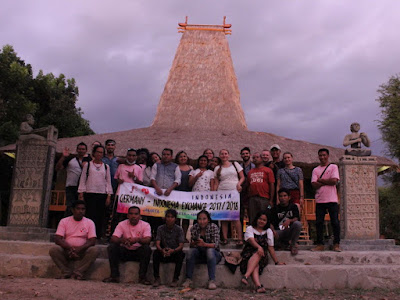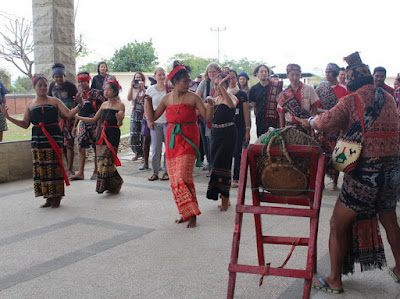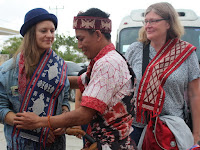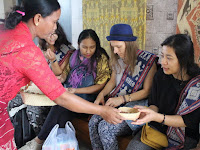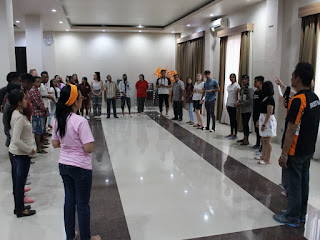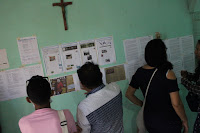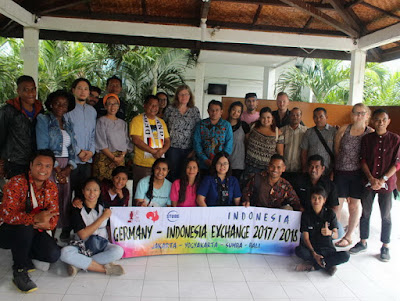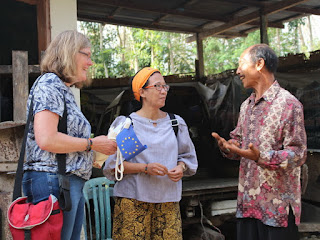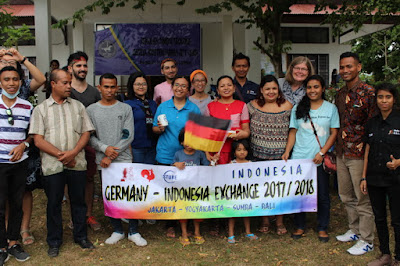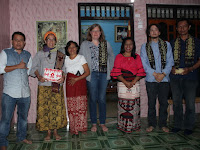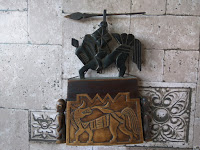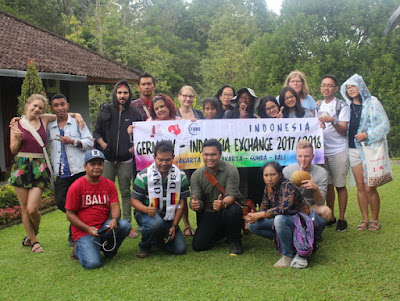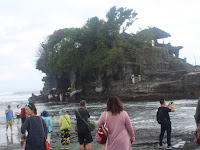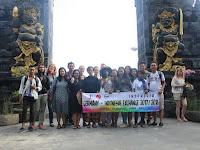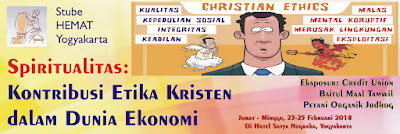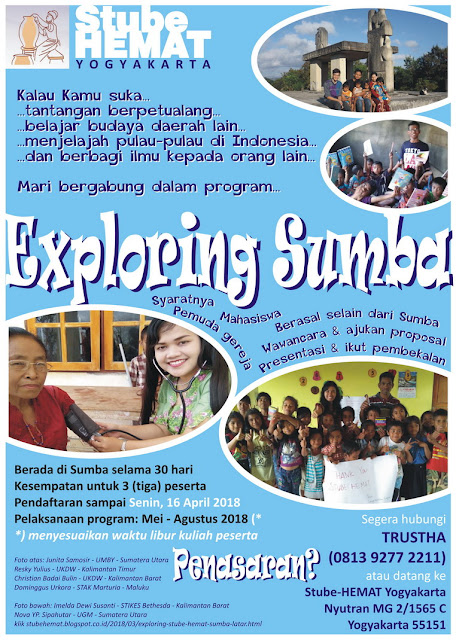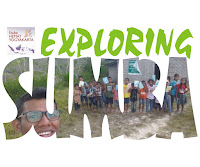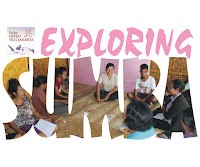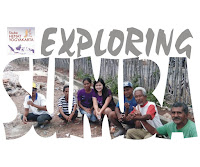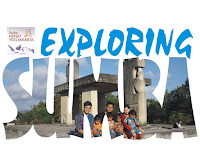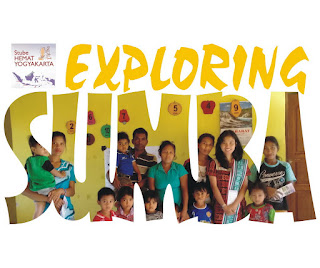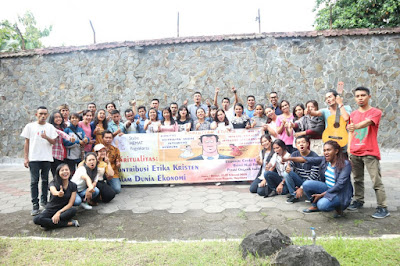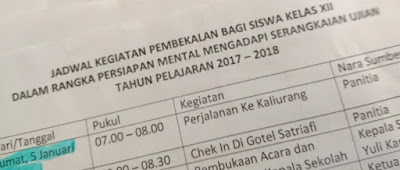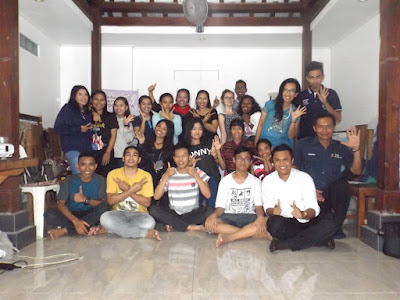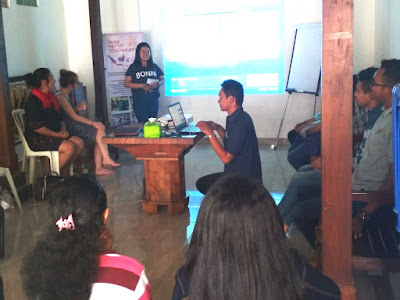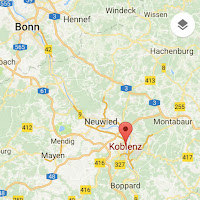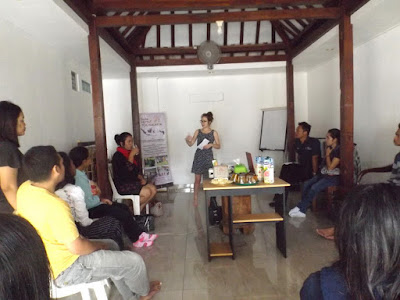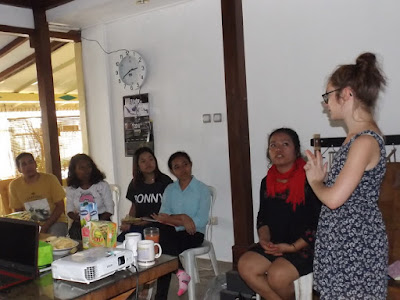Admiring Batik and Caring for the Environment
Wednesday, 12 December 2018by adminstube
 Seeing see a long row of beautiful batik being worked on has become a source of reflection for all of us. Of course, this method brings forward consequences on quality and price. Affordable price for the consumer while also brings profit to the producer is a mutual desire. Even though alternatives natural coloring is available, in the business realm profit is still a priority, and synthetic color that’s much cheaper and affordable is still one major option. When the natural colored product is sold at the markets, the price will be much higher. Furthermore, natural coloring process requires multiple immersion to create the desired color.
Seeing see a long row of beautiful batik being worked on has become a source of reflection for all of us. Of course, this method brings forward consequences on quality and price. Affordable price for the consumer while also brings profit to the producer is a mutual desire. Even though alternatives natural coloring is available, in the business realm profit is still a priority, and synthetic color that’s much cheaper and affordable is still one major option. When the natural colored product is sold at the markets, the price will be much higher. Furthermore, natural coloring process requires multiple immersion to create the desired color.
To what extent batik artisans manage their coloring and wax waste? It’s not a secret that batik artisans color their batik with synthetic color, one of which is Naphthol. Naphthol, a compound with the formula C10H8O; molar mass: 144,17 g/mol; water solubility: 0,74 kg/m3; boiling point: 285°C; density: 1,22 g/cm³; ChEBI ID: 10432. This material belongs to B3 (Bahan Beracun dan Berbahaya / Toxic and Dangerous Substances) materials. This type of material is hazardous for humans, animals, and the environment’s health. Naphthol can wipe out underwater organisms because of its ability to change biochemical oxygen demand (BOD) and chemical oxygen demand (COD) value on the water. Therefore, solid or liquid waste that contains B3 needs extra measures so it can be decomposed in such manner that doesn’t harm the environment. According to the Government Regulation Number 101 Year 2014 about Toxic and Dangerous Substances Waste Management, article 3 verse (1) ‘Anyone who creates B3 waste, must manage the B3 waste that was created’.
 Providing know-how to batik artisans on the topic of environment preservation and the usage of protective suits during the coloring process is critical, in order to not to be exposed to chemicals in a close range. If contacting with chemicals was often made, especially B3 chemicals, it could cause long-term illnesses such as skin cancer.
Providing know-how to batik artisans on the topic of environment preservation and the usage of protective suits during the coloring process is critical, in order to not to be exposed to chemicals in a close range. If contacting with chemicals was often made, especially B3 chemicals, it could cause long-term illnesses such as skin cancer.
Learning Batik In Giriloyo
Monday, 10 December 2018by adminstube
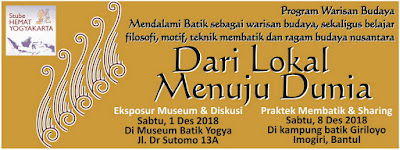 The end of 2018 is filled with a touch of a slightly more expressive activity, namely Batik training as a cultural heritage. With the theme "From Local to World", the activity held on December 8th, 2018 is not the first, but the continuation of activities on December 1st, 2018.
The end of 2018 is filled with a touch of a slightly more expressive activity, namely Batik training as a cultural heritage. With the theme "From Local to World", the activity held on December 8th, 2018 is not the first, but the continuation of activities on December 1st, 2018.
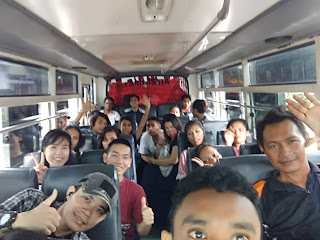 Early in the morning at around 8:30 A.M., all participants gathered at Stube-HEMAT Yogyakarta secretariat to get directions on what they should do in the place of batik and present the meaning of local motifs they had drawn. Twenty-eight students and the team departed and wish to be able to make a good batik at Giriloyo, Imogiri.
Early in the morning at around 8:30 A.M., all participants gathered at Stube-HEMAT Yogyakarta secretariat to get directions on what they should do in the place of batik and present the meaning of local motifs they had drawn. Twenty-eight students and the team departed and wish to be able to make a good batik at Giriloyo, Imogiri.
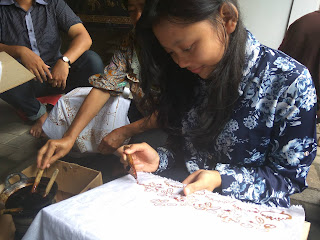 Even though it was the first time, most of the participants looked very smoothly drawing with hot wax on cloth using ‘canting’. Some participants were still assisted by ‘pecanting’, woman batik artisans. The process of sticking turned out to be fun, as the wax was smeared in the fabric, the batik imagination was increasingly challenged to continue to explore the motif until it was finished.
Even though it was the first time, most of the participants looked very smoothly drawing with hot wax on cloth using ‘canting’. Some participants were still assisted by ‘pecanting’, woman batik artisans. The process of sticking turned out to be fun, as the wax was smeared in the fabric, the batik imagination was increasingly challenged to continue to explore the motif until it was finished.
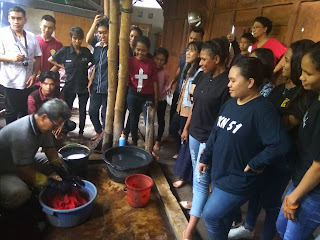 After lunch, the coloring process was the final touch of that day activities. Between the two color choices, red and blue, blue dominated the choice for coloring. Some steps must be taken: the first step, the fabric was moistened with water mixed with TRO detergent and then lifted; second step, the fabric was put into naptol water then lifted; the third step, the cloth that would be colored with red was put into water mixed with R red salt and the cloth that would be colored with blue was put in water mixed with B blue salt; the fourth step, the process of cleaning the wax by putting the cloth into boiling water that has been mixed with soda ash; and the final step was drying the fabric.
After lunch, the coloring process was the final touch of that day activities. Between the two color choices, red and blue, blue dominated the choice for coloring. Some steps must be taken: the first step, the fabric was moistened with water mixed with TRO detergent and then lifted; second step, the fabric was put into naptol water then lifted; the third step, the cloth that would be colored with red was put into water mixed with R red salt and the cloth that would be colored with blue was put in water mixed with B blue salt; the fourth step, the process of cleaning the wax by putting the cloth into boiling water that has been mixed with soda ash; and the final step was drying the fabric.
Finding out 20 meanings of batik motifs
Thursday, 6 December 2018by adminstube
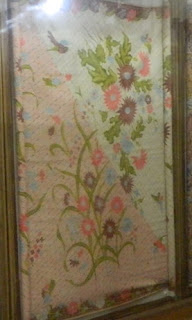 The motif of Morning and Afternoon batik. In the past time, noble people had more than one batik, while common people only had one. Then it pushed common people for an idea to design a piece of batik with two different colors, lighter and darker. Darker motif was worn in the afternoon, while the brighter one was worn at the day time.
The motif of Morning and Afternoon batik. In the past time, noble people had more than one batik, while common people only had one. Then it pushed common people for an idea to design a piece of batik with two different colors, lighter and darker. Darker motif was worn in the afternoon, while the brighter one was worn at the day time.
 The motif of Tirta Teja batik. ‘Tirta’ means water and ‘Teja’ means light. By wearing this batik, those who work, travel or migrate, are expected to be more adaptive at the new places and able to give enlightment to the surrounding.
The motif of Tirta Teja batik. ‘Tirta’ means water and ‘Teja’ means light. By wearing this batik, those who work, travel or migrate, are expected to be more adaptive at the new places and able to give enlightment to the surrounding.
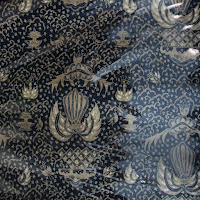 The motif of Semen Rejo batik. The word ‘semen’ means sprouts and ‘reja’ means prosper. By wearing this motif, people will have a hope and prosperous life wherever they are.
The motif of Semen Rejo batik. The word ‘semen’ means sprouts and ‘reja’ means prosper. By wearing this motif, people will have a hope and prosperous life wherever they are.
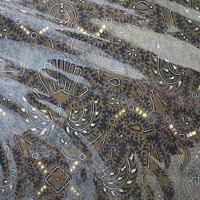 The motif of Semen Gurdo batik. The word ‘semen’ means sprouts and ‘gurda’ means eagle. By wearing this motif, people will have a new hope and have power in the future.
The motif of Semen Gurdo batik. The word ‘semen’ means sprouts and ‘gurda’ means eagle. By wearing this motif, people will have a new hope and have power in the future.
 The motif of Parang Rusak Seling Nitik batik. It shows the nobility of a king. In ancient times only Sultan was allowed to wear it. However, by filling space between the patterns with dots or ‘Seling Nitik’, common people may also wear it. Since Sultan Hamengkubuwono the 7th, this batik motif can be worn generally without exception.
The motif of Parang Rusak Seling Nitik batik. It shows the nobility of a king. In ancient times only Sultan was allowed to wear it. However, by filling space between the patterns with dots or ‘Seling Nitik’, common people may also wear it. Since Sultan Hamengkubuwono the 7th, this batik motif can be worn generally without exception.
The motif of Wahyu Tumurun batik. It describes a hope to get guidance, blessings, mercy, and abundant grace from God the Almighty, to have success in achieving goals, position or rank. (https://infobatik.id/keunikan-makna-filosofi-batik-klasik-motif-wahyu-tumurun/). (SAP)
From Local to Global Exposure to Batik Museum of Yogyakarta
Monday, 3 December 2018by adminstube
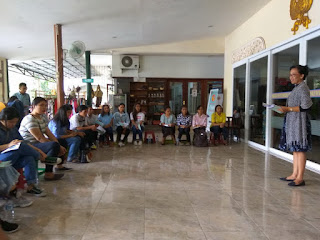 "Stube-HEMAT as mentoring institution for students from various regions in Indonesia who study in Yogyakarta equips students with knowledge and skills so that students have ‘added value’ through the programs in it. Students from various majors such as engineering, economics, governance, education and theology learn not only the subject of their study but also know the local culture of Yogyakarta such as Batik and are expected to create new innovation with local content from their origin, "said Ariani Narwastujati, the executive director of Stube-HEMAT.
"Stube-HEMAT as mentoring institution for students from various regions in Indonesia who study in Yogyakarta equips students with knowledge and skills so that students have ‘added value’ through the programs in it. Students from various majors such as engineering, economics, governance, education and theology learn not only the subject of their study but also know the local culture of Yogyakarta such as Batik and are expected to create new innovation with local content from their origin, "said Ariani Narwastujati, the executive director of Stube-HEMAT.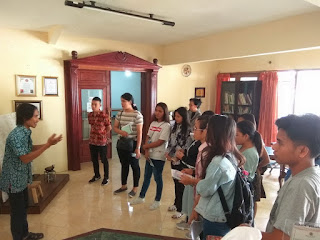 During the visit to the museum (1/12/2018), participants were divided into two small groups to explore the museum. The group one accompanied by Didik, the tour guide, began to learn the history of the museum which was pioneered by Hadi Nugroho's family with Dewi Sukaningsih, his wife. The spouse revealed their anxiety on the preservation of batik because many high-quality batik sheets were cut into pieces to make clothes without thinking about the meaning of the batik itself. Furthermore, the participants observed batik equipment such as canting, heating, wax, coloring, motif stamps and steps of making batik from 'ngeblat' (drawing) motifs to 'nglorot' (removing) wax. The Kraton-motifs batik are displayed there such as Sidomukti, Parang, and Kawung. Other motifs are ‘Udan Liris’ (drizzling rain), 'Truntum' and ‘Pisang Bali’. In the exhibition room there is ‘bledak’ batik, a batik made for ordinary people with natural nuances such as leaves, animals and natures around humans. Some participants wanted to know which motifs are suitable for young people. Didik mentioned Grompol and Madubronto.
During the visit to the museum (1/12/2018), participants were divided into two small groups to explore the museum. The group one accompanied by Didik, the tour guide, began to learn the history of the museum which was pioneered by Hadi Nugroho's family with Dewi Sukaningsih, his wife. The spouse revealed their anxiety on the preservation of batik because many high-quality batik sheets were cut into pieces to make clothes without thinking about the meaning of the batik itself. Furthermore, the participants observed batik equipment such as canting, heating, wax, coloring, motif stamps and steps of making batik from 'ngeblat' (drawing) motifs to 'nglorot' (removing) wax. The Kraton-motifs batik are displayed there such as Sidomukti, Parang, and Kawung. Other motifs are ‘Udan Liris’ (drizzling rain), 'Truntum' and ‘Pisang Bali’. In the exhibition room there is ‘bledak’ batik, a batik made for ordinary people with natural nuances such as leaves, animals and natures around humans. Some participants wanted to know which motifs are suitable for young people. Didik mentioned Grompol and Madubronto.
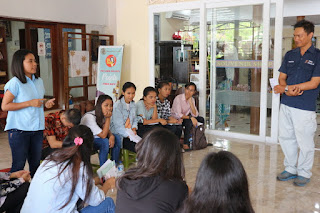 After observing the various collection of the museum the participants shared their new experiences. Sarlota Wantaar from Southeast Maluku, who study Physics Education at University of Sarjanawiyata Tamansiswa (UST) revealed that she learned the history of batik and understood that batik cloth had certain messages. Florida da Silva from Atambua, also study at UST, said that this visit reminded her childhood when her grandmother invited her to weave and love local culture. "After learning here, I came to know that when we will wear batik-patterned clothes, we shoul think about not just the beautiful looking, but when you wear it, you should know the meaning and purpose of the batik itself," said Florida.
After observing the various collection of the museum the participants shared their new experiences. Sarlota Wantaar from Southeast Maluku, who study Physics Education at University of Sarjanawiyata Tamansiswa (UST) revealed that she learned the history of batik and understood that batik cloth had certain messages. Florida da Silva from Atambua, also study at UST, said that this visit reminded her childhood when her grandmother invited her to weave and love local culture. "After learning here, I came to know that when we will wear batik-patterned clothes, we shoul think about not just the beautiful looking, but when you wear it, you should know the meaning and purpose of the batik itself," said Florida.Finding out batik motif and its philosophy
Thursday, 29 November 2018by adminstube
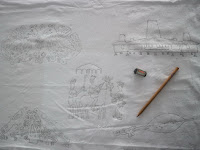 Those motifs that the team are proud of, have various styles, such as leaves and passion fruit that mean growing to shade because these plants can grow quickly, live anywhere, and their thick leaves can be used as shade and protectors from sun light, while the fruits contain vitamins. The tamarind leaf motif, which is Javanese 'tamarind' has a meaning of making people 'interested' or happy to see it. The team originating from Sumba promoted its local motifs, such as Cockatoos, Parrots, traditional house and Mamuli, iconic item used by Sumbanese as ‘belis’ (dowry) for marriage. Cockatoos and parrots symbolize sense of togetherness and brotherhood besides their unique chirps. While the motifs of yellow chest hornbills and angelbirds were drawn by team from Halmahera. Hornbills are indigenous birds that are respected in East Halmahera and Angelbirds are rare birds because they only exist in North Halmahera. Never miss the design of whale motif and ‘Tatong’, traditional musical instruments drawn by team from Lembata.
Those motifs that the team are proud of, have various styles, such as leaves and passion fruit that mean growing to shade because these plants can grow quickly, live anywhere, and their thick leaves can be used as shade and protectors from sun light, while the fruits contain vitamins. The tamarind leaf motif, which is Javanese 'tamarind' has a meaning of making people 'interested' or happy to see it. The team originating from Sumba promoted its local motifs, such as Cockatoos, Parrots, traditional house and Mamuli, iconic item used by Sumbanese as ‘belis’ (dowry) for marriage. Cockatoos and parrots symbolize sense of togetherness and brotherhood besides their unique chirps. While the motifs of yellow chest hornbills and angelbirds were drawn by team from Halmahera. Hornbills are indigenous birds that are respected in East Halmahera and Angelbirds are rare birds because they only exist in North Halmahera. Never miss the design of whale motif and ‘Tatong’, traditional musical instruments drawn by team from Lembata.
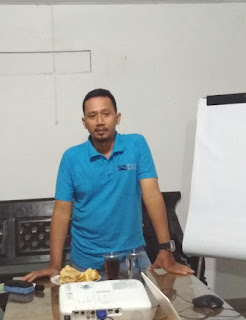 The motives that have been drawn on piece of cloth then were discussed in the workshop accompanied by Heru Santoso, a batik practitioner, on Friday 11/23/2018 at 6:00-8.00pm at Stube-HEMAT Yogyakarta secretariat. After discussing the Batik results done by the team, the workshop was the first debriefing on batik process. In his presentation, Heru Santoso explained three types of batik, namely written batik, stamp and written combination and stamp. As time went on, new types of batik emerged, such as Sibori, Jumput, Celup, Colet, and Ecoprint. Batik itself is indeed a process of hindering colors on the fabric to produce motifs, whether using wax, folds or twists. "Actually, there are unique batik abroad, however only batik and motifs from Indonesia are considered interesting and unique with high level of complexity so that they are appreciated more," he explained.
The motives that have been drawn on piece of cloth then were discussed in the workshop accompanied by Heru Santoso, a batik practitioner, on Friday 11/23/2018 at 6:00-8.00pm at Stube-HEMAT Yogyakarta secretariat. After discussing the Batik results done by the team, the workshop was the first debriefing on batik process. In his presentation, Heru Santoso explained three types of batik, namely written batik, stamp and written combination and stamp. As time went on, new types of batik emerged, such as Sibori, Jumput, Celup, Colet, and Ecoprint. Batik itself is indeed a process of hindering colors on the fabric to produce motifs, whether using wax, folds or twists. "Actually, there are unique batik abroad, however only batik and motifs from Indonesia are considered interesting and unique with high level of complexity so that they are appreciated more," he explained.
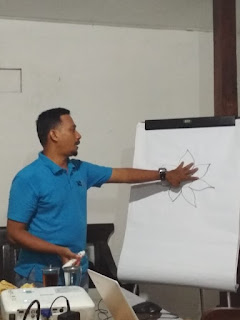 Main pattern is needed in drawing motif and then its edge is decorated with a fringe pattern and the rest is added by ‘isen-isen’ or fillings on the blank part of the fabric, in order to beautify overall motif. As a note, the Stube team members are beginner, it is recommended to make a bigger motif, to make it easier when the process of 'canting'. Sometimes, motifs of bird, fish or human needed to be disguised without eliminating the essence of the motif, or called Stylation process, because basically batik is different from painting so the motif does not have the same details. That is the aesthetic value of a motif.
Main pattern is needed in drawing motif and then its edge is decorated with a fringe pattern and the rest is added by ‘isen-isen’ or fillings on the blank part of the fabric, in order to beautify overall motif. As a note, the Stube team members are beginner, it is recommended to make a bigger motif, to make it easier when the process of 'canting'. Sometimes, motifs of bird, fish or human needed to be disguised without eliminating the essence of the motif, or called Stylation process, because basically batik is different from painting so the motif does not have the same details. That is the aesthetic value of a motif.
This small workshop enlightened all Stube team member in designing motifs and color selection. Hopefully the next process of making batik will run well and produce unique works. Have nice process. (ML).
Discovering Traditional Batik Spots in Yogyakarta
Wednesday, 28 November 2018by adminstube
by adminstube
Batik: Crossing the Border of People
Tuesday, 27 November 2018by adminstube
Classic Batik and Contemporary Touch
Saturday, 17 November 2018by adminstube
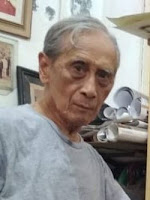 To know and learn about classical batik and the fusion of contemporary batik – which is a recent trend –, on Monday, 12th of November 2018, we managed to interview one of batik producer, R.M. Kumarhadi Suryoputro, S.E (aged 78) at his house. Romo Kumar, his nickname, is the grandson of Sultanate Hamengku Buwono VIII. Currently, he acts as a financial staff for the Ngayogyakarta Hadiningrat palace. He claimed that he is a batik artist. His works are for sale at the Kumar batik shop, located at the palace’s surroundings. Now he only created batik patterns and motifs, his son who manages the shop has limited edition handmade motif batik brands.
To know and learn about classical batik and the fusion of contemporary batik – which is a recent trend –, on Monday, 12th of November 2018, we managed to interview one of batik producer, R.M. Kumarhadi Suryoputro, S.E (aged 78) at his house. Romo Kumar, his nickname, is the grandson of Sultanate Hamengku Buwono VIII. Currently, he acts as a financial staff for the Ngayogyakarta Hadiningrat palace. He claimed that he is a batik artist. His works are for sale at the Kumar batik shop, located at the palace’s surroundings. Now he only created batik patterns and motifs, his son who manages the shop has limited edition handmade motif batik brands.
Batik which he made is for sale for prices ranging from two hundred fifty thousand rupiahs, up to millions per sheet. His batiks will never be the same with others’ because he designed it himself, utilizing a harmony of contemporary and classic batik motifs. Interesting isn’t it? If you want to know more about batik, keep an eye to our website around November-December 2018 for articles about batik. (SAP).
by adminstube
 Canting has 3 main parts, i.e. Nyamplung, cucuk, and gagang. Nyamplung is a vessel of the liquid wax which is made of copper. Cucuk is a place where the wax comes out, and Gagang is canting handle which is made of bamboo or wood. Not only to make a pattern, canting has also a philosophy on every part of it. Three main parts of canting have means that is, ‘Gagang’ has a meaning of a strong base of faith to God, then ‘Nyamplung’ has meaning of magnanimity to mend life problem, and ‘Cucuk’ symbolizes a term of talk less, work more. This part has a small size and the users have to be really careful if they want to take the wax out of it. It is important point that those who want to make batik understand the pattern philosophy of batik that they want to make, because it has thousands pattern and meaning.
Canting has 3 main parts, i.e. Nyamplung, cucuk, and gagang. Nyamplung is a vessel of the liquid wax which is made of copper. Cucuk is a place where the wax comes out, and Gagang is canting handle which is made of bamboo or wood. Not only to make a pattern, canting has also a philosophy on every part of it. Three main parts of canting have means that is, ‘Gagang’ has a meaning of a strong base of faith to God, then ‘Nyamplung’ has meaning of magnanimity to mend life problem, and ‘Cucuk’ symbolizes a term of talk less, work more. This part has a small size and the users have to be really careful if they want to take the wax out of it. It is important point that those who want to make batik understand the pattern philosophy of batik that they want to make, because it has thousands pattern and meaning.Glancing At Local Motifs For Batik
Friday, 16 November 2018by adminstube
Batik: Between Techniques and Pattern Motif
Thursday, 15 November 2018by adminstube
Then what about the claims of batik for jumput and sibori? Jumput and Shibori do not use wax to block color, so can it be said batik? Referring to the definition in the dictionary above, the jumput and sibori cannot be said to be batik, because they do not use wax in the process. Common people that it is batik because they saw the color blocking process carried out to get the motif, such as by doing ties, folds, or even twists. Now, can you distinguish which one is batik and the other isnot?
Indonesian Batik from Time to Time
Thursday, 15 November 2018by adminstube
Batik: Revealing the Meaning Grabbing the Hope Batik Museum of Yogyakarta and Ullen Sentalu
Monday, 5 November 2018by adminstube
 The batik fabrics with ‘Kawung, Truntum, and Sidomukti’ patterns are displayed towelcome visitors at Batik Museum of Yogyakarta located on Jalan Sutomo no. 13 A, Yogyakarta. This is the first batik museum in Indonesiahaving thousand collections of batik cloth. The museum was founded as the initiative of the family of Hadi Nugroho and R. Ng. Jumima Dewi Sukaningsih in 1977, because of their love to batik as well as desolation because they often recognized that many pieces of batik wereused as clothing material without considering the meaning of the pattern. Entering this museum, visitors are brought to the past atmosphere because of various ancient furnitures and photo decorations, and collections of old batik fabrics, tens or even hundreds years old are displayed around the room, including various types and functions of ‘canting’.
The batik fabrics with ‘Kawung, Truntum, and Sidomukti’ patterns are displayed towelcome visitors at Batik Museum of Yogyakarta located on Jalan Sutomo no. 13 A, Yogyakarta. This is the first batik museum in Indonesiahaving thousand collections of batik cloth. The museum was founded as the initiative of the family of Hadi Nugroho and R. Ng. Jumima Dewi Sukaningsih in 1977, because of their love to batik as well as desolation because they often recognized that many pieces of batik wereused as clothing material without considering the meaning of the pattern. Entering this museum, visitors are brought to the past atmosphere because of various ancient furnitures and photo decorations, and collections of old batik fabrics, tens or even hundreds years old are displayed around the room, including various types and functions of ‘canting’.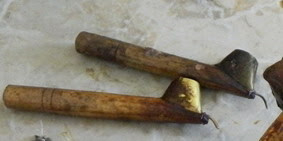 Canting is a batik tool, consist of copper cup for liquid wax and wood as the handle. Other ingredients used to make batik are 'malam' or paraffin, ‘gondorukem’ (gum damar), honeycomb nests and other ingredients. The word 'Batik' does not refer to cloth with its certain pattern but the process of creating a work using wax and colouring. The process of batik itself consists of Nglowong, pouring wax on the pattern on the fabric; Nembok, pouring wax on the pattern image to protect the base color; Medel, giving the first color, usually dark;Ngerok, removing wax in certain parts using ‘cawuk’ (scraping tool); Mbironi, pouring wax to certain parts to protect the fabric during the second colouring phase; Nyoga, colouring fabric with soga or brown colour using Soga barks as natural colouring; and Nglorot, cleaning all the wax in the cloth by boiling the fabrics.
Canting is a batik tool, consist of copper cup for liquid wax and wood as the handle. Other ingredients used to make batik are 'malam' or paraffin, ‘gondorukem’ (gum damar), honeycomb nests and other ingredients. The word 'Batik' does not refer to cloth with its certain pattern but the process of creating a work using wax and colouring. The process of batik itself consists of Nglowong, pouring wax on the pattern on the fabric; Nembok, pouring wax on the pattern image to protect the base color; Medel, giving the first color, usually dark;Ngerok, removing wax in certain parts using ‘cawuk’ (scraping tool); Mbironi, pouring wax to certain parts to protect the fabric during the second colouring phase; Nyoga, colouring fabric with soga or brown colour using Soga barks as natural colouring; and Nglorot, cleaning all the wax in the cloth by boiling the fabrics.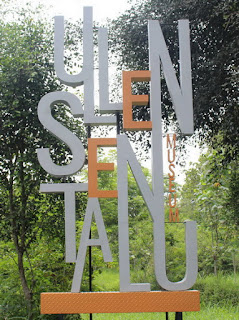 Next is Ullen Sentalu Museum in Kaliurang, a museum that combines nature and preservation of the Mataraman Javanese cultural heritages. The museum was pioneered by Haryono family since 1994 and officially opened to the public on March 1, 1997. 'Ullen Sentalu' is an acronym forULating bLENcong SEjatiNeTAtaraning LUmaku which means a ray of light that illuminates the journey of life. Blencong is a lighting device on the shadow puppet stage. The museum's architecture is unique because it combines Indis and modern buildings, some of which are below the ground level and some conform the contours with its twisting aisle and its stone floors. Another uniqueness of Ullen Sentalu is no text explanation displayed on each item. Direct narration from the guide is the only bridge of interaction between ancient cultural heritage objects with the visitorsthat they can listen to past events and makereflection at the present time.
Next is Ullen Sentalu Museum in Kaliurang, a museum that combines nature and preservation of the Mataraman Javanese cultural heritages. The museum was pioneered by Haryono family since 1994 and officially opened to the public on March 1, 1997. 'Ullen Sentalu' is an acronym forULating bLENcong SEjatiNeTAtaraning LUmaku which means a ray of light that illuminates the journey of life. Blencong is a lighting device on the shadow puppet stage. The museum's architecture is unique because it combines Indis and modern buildings, some of which are below the ground level and some conform the contours with its twisting aisle and its stone floors. Another uniqueness of Ullen Sentalu is no text explanation displayed on each item. Direct narration from the guide is the only bridge of interaction between ancient cultural heritage objects with the visitorsthat they can listen to past events and makereflection at the present time.
Two Hours to Know Indonesia
Wednesday, 31 October 2018by adminstube
 Beside getting to know each other and introduce themselves the event presented a Nusantara Quiz to get to know Indonesia and Indonesia at a glance. Most of the participants were students from outside of Yogyakarta even out side Java island, such as West Nusa Tenggara, Lampung, Kalimantan and East Nusa Tenggara. The atmosphere became more lively when the participants were invited to be involved in the quiz / Smart Quiz of the Archipelago. The spirit of recognizing again the diversity and wealth of Indonesia from Sabang to Merauke, such as Indonesia's outer islands, provincial capitals, historical places in Yogyakarta, traditional songs, traditional clothing, and historic cities of colonialism to independence, radiated from each participant.
Beside getting to know each other and introduce themselves the event presented a Nusantara Quiz to get to know Indonesia and Indonesia at a glance. Most of the participants were students from outside of Yogyakarta even out side Java island, such as West Nusa Tenggara, Lampung, Kalimantan and East Nusa Tenggara. The atmosphere became more lively when the participants were invited to be involved in the quiz / Smart Quiz of the Archipelago. The spirit of recognizing again the diversity and wealth of Indonesia from Sabang to Merauke, such as Indonesia's outer islands, provincial capitals, historical places in Yogyakarta, traditional songs, traditional clothing, and historic cities of colonialism to independence, radiated from each participant.
This program accommodated young people to meet and embrace interfaith friends to communicate. If the problem can be solved by communication, then there will be no violence that takes casualties. Let's join hands and work hand in hand against injustice done on the name of religion. (SAP).
Wednesday, 31 October 2018
by adminstube
Inspiring Though
in Limitations
Saturday, 13 October 2018by adminstube
 The school founded by ‘Dena-Upakara’ Foundation, actually continues the work of Dutch missionaries in Wonosobo since 1938. Since 1996, this foundation has developed education for people with double mental disabilities including deaf, deaf and blind, and deaf and low vision with a name of Helen Keller Indonesia SLB/G-AB located in Yogyakarta (http://www.slbhki-jogjakarta.com /about Us).
The school founded by ‘Dena-Upakara’ Foundation, actually continues the work of Dutch missionaries in Wonosobo since 1938. Since 1996, this foundation has developed education for people with double mental disabilities including deaf, deaf and blind, and deaf and low vision with a name of Helen Keller Indonesia SLB/G-AB located in Yogyakarta (http://www.slbhki-jogjakarta.com /about Us).
Getting to Know Wildlife Rescue Center (WRC)
Saturday, 13 October 2018by adminstube
 The Wildlife Rescue Center (WRC) is a project held by Yogyakarta Nature Conservation Foundation which main activity isrehabilitating and caring for confiscated wild animals. The treated animals are animals that cannot be kept legally, traded intact or dead by people. The Wildlife Rescue Center (WRC) covers 14 hectares located on Pengasih – Nanggulan street, Derwelo, Sendangsari, Kulonprogo regency, Yogyakarta.
The Wildlife Rescue Center (WRC) is a project held by Yogyakarta Nature Conservation Foundation which main activity isrehabilitating and caring for confiscated wild animals. The treated animals are animals that cannot be kept legally, traded intact or dead by people. The Wildlife Rescue Center (WRC) covers 14 hectares located on Pengasih – Nanggulan street, Derwelo, Sendangsari, Kulonprogo regency, Yogyakarta. Dr. Arini, one of the veterinarians who managed and cared for the animals introduced the vision of WRC’s establishment and told the students how to handle and care to the wildlife. However,during this visit the wild animals kept in quarantine cannot be visited by humans for certain reasons such as transmission of diseases. After that the students were invited to go around and play fun games in 2 groups. This game encoureged sudents to know more detail about the various plants and trees and the kinds of insects they see. At the end of the visit they presented what they had learned.
Dr. Arini, one of the veterinarians who managed and cared for the animals introduced the vision of WRC’s establishment and told the students how to handle and care to the wildlife. However,during this visit the wild animals kept in quarantine cannot be visited by humans for certain reasons such as transmission of diseases. After that the students were invited to go around and play fun games in 2 groups. This game encoureged sudents to know more detail about the various plants and trees and the kinds of insects they see. At the end of the visit they presented what they had learned. The students were very enthusiasticto participate the activities sincethe beginning until the end. Identifying various kinds of trees and types of insects they saw was a new experience forthem. Even more surprising when they saw a large crocodile in a cage. Some were happy and someothers were screaming out hysterically because of fear. This was something interesting for them to see it for the first time. Through Social Study activity is expected that the students of Tirtamarta Christian Junior High School – BPK Penabur Pondok Indah Jakarta are getting to know, care and love natural environment and animals. (ELZ)
The students were very enthusiasticto participate the activities sincethe beginning until the end. Identifying various kinds of trees and types of insects they saw was a new experience forthem. Even more surprising when they saw a large crocodile in a cage. Some were happy and someothers were screaming out hysterically because of fear. This was something interesting for them to see it for the first time. Through Social Study activity is expected that the students of Tirtamarta Christian Junior High School – BPK Penabur Pondok Indah Jakarta are getting to know, care and love natural environment and animals. (ELZ)How Much Is My Human Fellow? Social Studies done by students of Tirtamarta Junior High School-BPK Penabur, Pondok Indah Jakarta
Saturday, 13 October 2018by adminstube


 Live-in activities gave students opportunity to stay and to do activitites for three days and two nights with twenty-six families of Wates Selatan Javanese Christian Church (GKJ), Kulonprogo,deployed in Triharjo (Wates), Depok (Panjatan), Kranggan and Sidorejo (Galur) and Jatisari (Lendah). The companion from Stube-HEMAT helped students to know their family, local environment and activities, such as planting rice, feeding chickens and harvesting eggs, drawing water, bathing livestock, making plaits, cooking, sweeping, making copra, selling coconuts, watering vegetables and planting with hydroponic media. "What a memorable experience," said the students.
Live-in activities gave students opportunity to stay and to do activitites for three days and two nights with twenty-six families of Wates Selatan Javanese Christian Church (GKJ), Kulonprogo,deployed in Triharjo (Wates), Depok (Panjatan), Kranggan and Sidorejo (Galur) and Jatisari (Lendah). The companion from Stube-HEMAT helped students to know their family, local environment and activities, such as planting rice, feeding chickens and harvesting eggs, drawing water, bathing livestock, making plaits, cooking, sweeping, making copra, selling coconuts, watering vegetables and planting with hydroponic media. "What a memorable experience," said the students.
The Millennial Loves Batik
Saturday, 13 October 2018by adminstube
 One of the activities was visiting and practicing batik at Batik Sungsang Giriloyo, Imogiri, Bantul Regency. On October 10, 2018, 13 students, 2 teachers and 2 companion students from Stube-HEMAT visited the location eitherto learn about history and to practice making batik.
One of the activities was visiting and practicing batik at Batik Sungsang Giriloyo, Imogiri, Bantul Regency. On October 10, 2018, 13 students, 2 teachers and 2 companion students from Stube-HEMAT visited the location eitherto learn about history and to practice making batik.
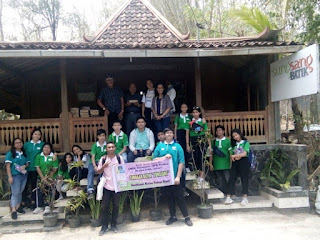 When practicing batik, studentswere very enthusiastic about making their own batik. Startedfrom the process of drawing pattern, then it was drawn using wax with a tool called canting, and then it was continued with the coloring process, after that the cloth was boiled to remove the wax and then cloth was washed and dried underthe sun. Even though the results were not as fine asthe batik made by women in Giriloyo, the students were proud of their own work. Their passion needs to be fostered in order to love and to be proud of using authentic Indonesian product, that is batik. (ML).
When practicing batik, studentswere very enthusiastic about making their own batik. Startedfrom the process of drawing pattern, then it was drawn using wax with a tool called canting, and then it was continued with the coloring process, after that the cloth was boiled to remove the wax and then cloth was washed and dried underthe sun. Even though the results were not as fine asthe batik made by women in Giriloyo, the students were proud of their own work. Their passion needs to be fostered in order to love and to be proud of using authentic Indonesian product, that is batik. (ML).Bumi Langit The Earth Needs Me
Saturday, 13 October 2018by adminstube
 Bumi Langit Institute is one institution that dedicates their time and mind to cultivate nature in a good and appropriate way. It is a place where ethical values become the basic foundation in human relation with nature and among humans. The institute was founded in May 2014 with concept of a comprehensive approach to life (permaculture). The field of Bumi Langit is an open garden that enables people to see and learn together the mutual relationships between human and their environment.
Bumi Langit Institute is one institution that dedicates their time and mind to cultivate nature in a good and appropriate way. It is a place where ethical values become the basic foundation in human relation with nature and among humans. The institute was founded in May 2014 with concept of a comprehensive approach to life (permaculture). The field of Bumi Langit is an open garden that enables people to see and learn together the mutual relationships between human and their environment.
 Welcomed by Ms. Nung, one of the administrators of the Bumi Langit institute, the dialogue began with the history of the establishment of the Bumi Langit institute. Students were also invited to see the garden. There were various types of organic vegetable and fruit plants. There are also farms, agriculture, bio gas processing, clean water processing, and electricity generated by solar power.
Welcomed by Ms. Nung, one of the administrators of the Bumi Langit institute, the dialogue began with the history of the establishment of the Bumi Langit institute. Students were also invited to see the garden. There were various types of organic vegetable and fruit plants. There are also farms, agriculture, bio gas processing, clean water processing, and electricity generated by solar power.
Discerning the Rhythm of Life at Omah Cangkem Mataraman
Saturday, 13 October 2018by adminstube
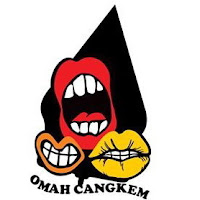 Pardiman explained the meaning of the name, Omah is ‘Rumah’ (house), Cangkem is Mulut (mouth) and Mataraman is a cultural area of Mataram (Mataram traditional area). So, Omah Cangkem Mataraman means home or place to produce sounds, not just sounds but voices of truth, harmony and expressions of love for culture, especially Javanese culture. It is beautiful, isn't it?
Pardiman explained the meaning of the name, Omah is ‘Rumah’ (house), Cangkem is Mulut (mouth) and Mataraman is a cultural area of Mataram (Mataram traditional area). So, Omah Cangkem Mataraman means home or place to produce sounds, not just sounds but voices of truth, harmony and expressions of love for culture, especially Javanese culture. It is beautiful, isn't it?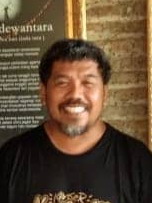 "This studio builds communication between young generation and ancestral cultural heritages, someof them are gamelan (javanese traditional music instruments), playing janur (coconut leaves), children's play, kentongan (music instrument), dance, nembang (singing), unggah-ungguh (polite attitudes), etc. We already knew that this nation is rich with its traditional arts, one of them is gamelan, which is so famous at the international level, but ironically gamelan itself has not been beloved in the chest of the nation’s youth. This is very sad because the sustainability of a nation depends on the next generation and cultures. Whereas history has recorded that this nation is so famous in the world because of its cultural heritages. So, it needs a kind of continuous efforts so that the young generation becomes ‘literate’ to culture and understand the potency of art and culture of their homeland" said Pardiman.
"This studio builds communication between young generation and ancestral cultural heritages, someof them are gamelan (javanese traditional music instruments), playing janur (coconut leaves), children's play, kentongan (music instrument), dance, nembang (singing), unggah-ungguh (polite attitudes), etc. We already knew that this nation is rich with its traditional arts, one of them is gamelan, which is so famous at the international level, but ironically gamelan itself has not been beloved in the chest of the nation’s youth. This is very sad because the sustainability of a nation depends on the next generation and cultures. Whereas history has recorded that this nation is so famous in the world because of its cultural heritages. So, it needs a kind of continuous efforts so that the young generation becomes ‘literate’ to culture and understand the potency of art and culture of their homeland" said Pardiman.
Religions
in the midst of
Political
Competition
in Indonesia
Monday, 24 September 2018by adminstube
 “Now, our society enters a new phase of Indonesian politics with electoral politics as the new standard. Everyone feels engaged inside politics. Everyone becomes politicians, churches become politicians, activists become politicians, everyone is involved in caring something that is not his/her job”, Prof. Cornelis said. In his opinion, religion and politics can complete each other. Religion values can be transferred into politics so that politics could be more orderly. “The discrepancy between fundamentalist Christian and Islam created a sense that Indonesian politics is trapped by those two things. The politics of identity increases, and it brings us to hate each other”, he said while giving an example of the fight between Osama bin Laden and George W. Bush.
“Now, our society enters a new phase of Indonesian politics with electoral politics as the new standard. Everyone feels engaged inside politics. Everyone becomes politicians, churches become politicians, activists become politicians, everyone is involved in caring something that is not his/her job”, Prof. Cornelis said. In his opinion, religion and politics can complete each other. Religion values can be transferred into politics so that politics could be more orderly. “The discrepancy between fundamentalist Christian and Islam created a sense that Indonesian politics is trapped by those two things. The politics of identity increases, and it brings us to hate each other”, he said while giving an example of the fight between Osama bin Laden and George W. Bush. Next, Buya Syafii Maarif stated that religion actually brought peace and harmony, but its adherents did not practice it. This is not the fault of religion or its holy book, but it is the fault of the person that did not understand what he/she believes in. He said confidently that deceiving people under the name of religion is so easy because their common sense has already been clouded by the lust of interests. Therefore, rational people must fight against such irrational culture. “Dear audience, being rational is very important”, he said, that was followed by laugh and applause from the attendants. Buya also left a message for the youth that they must not stay away from politics. Meanwhile for the adherents from multiple religions, he hoped that they involved in politics and not to turn a blind eye to it. Buya also hoped that everyone continues building a genuine relationship, not a fake one with others.
Next, Buya Syafii Maarif stated that religion actually brought peace and harmony, but its adherents did not practice it. This is not the fault of religion or its holy book, but it is the fault of the person that did not understand what he/she believes in. He said confidently that deceiving people under the name of religion is so easy because their common sense has already been clouded by the lust of interests. Therefore, rational people must fight against such irrational culture. “Dear audience, being rational is very important”, he said, that was followed by laugh and applause from the attendants. Buya also left a message for the youth that they must not stay away from politics. Meanwhile for the adherents from multiple religions, he hoped that they involved in politics and not to turn a blind eye to it. Buya also hoped that everyone continues building a genuine relationship, not a fake one with others.
 On the same occasion, Prof. A. Andreas Yewangoe said that politicization of religion and religionization of politics are classic issues and it is not new for us. We are as rational people must evaluate ourselves continuously to tackle this old issue. “Religion can be liberating and enslaving at the same time”, he said. “It depends on how people interpret the verses of their holy books. If it is interpreted with a negative view, it could be a verse used for a power abuse. It means that religion has lost its function,” he added assertively. However, he reminded that religion isn’t always negative. A reign that is managed positively will be a positive one. He thought that religion and politics might walk hand in hand and not assail each other, provided that the religious leaders are smart in sorting out between moral politics and praxis.
On the same occasion, Prof. A. Andreas Yewangoe said that politicization of religion and religionization of politics are classic issues and it is not new for us. We are as rational people must evaluate ourselves continuously to tackle this old issue. “Religion can be liberating and enslaving at the same time”, he said. “It depends on how people interpret the verses of their holy books. If it is interpreted with a negative view, it could be a verse used for a power abuse. It means that religion has lost its function,” he added assertively. However, he reminded that religion isn’t always negative. A reign that is managed positively will be a positive one. He thought that religion and politics might walk hand in hand and not assail each other, provided that the religious leaders are smart in sorting out between moral politics and praxis.Finding out The other side of Sumba and Bali participants’s activities of Germany-Indonesia Exchange 2017/2018 in Sumba and Bali islands
Wednesday, 8 August 2018by adminstube
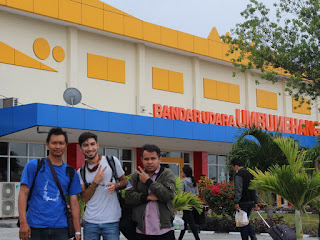 Visiting Sumba and Bali islands (2-6/08/2018) was the series program of Germany-Indonesia 2017/2018 after Jakarta and Yogyakarta. Flying by Nam Air from Yogyakarta to Waingapu, East Sumba and after a transit in Denpasar, Bali, the group landed safely in Sumba island. Arriving at the hotel, some students and activists of Stube-HEMAT Sumba welcomed the participants with a very unique East Sumba welcoming dance.
Visiting Sumba and Bali islands (2-6/08/2018) was the series program of Germany-Indonesia 2017/2018 after Jakarta and Yogyakarta. Flying by Nam Air from Yogyakarta to Waingapu, East Sumba and after a transit in Denpasar, Bali, the group landed safely in Sumba island. Arriving at the hotel, some students and activists of Stube-HEMAT Sumba welcomed the participants with a very unique East Sumba welcoming dance.

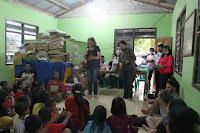 Furthermore, the group visited Frans Fredi's house, one of the Stube-HEMAT Sumba activists who labeled himself as a young farmer who took the initiative to develop independent organic farming on his land by planting rice, mustards, watermelon, melon and chilli. Next, a visit to Gracia reading group wasfacilitated by Septi Dadi, an ex-activist at Stube-HEMAT Yogyakarta, who had returned to Sumba and became a mathematics teacher at State Junior High School of Waingapu. Shehas a concern on children by pioneering a group ofreading and learning, accommodating children to learn and to develop themselves.
Furthermore, the group visited Frans Fredi's house, one of the Stube-HEMAT Sumba activists who labeled himself as a young farmer who took the initiative to develop independent organic farming on his land by planting rice, mustards, watermelon, melon and chilli. Next, a visit to Gracia reading group wasfacilitated by Septi Dadi, an ex-activist at Stube-HEMAT Yogyakarta, who had returned to Sumba and became a mathematics teacher at State Junior High School of Waingapu. Shehas a concern on children by pioneering a group ofreading and learning, accommodating children to learn and to develop themselves.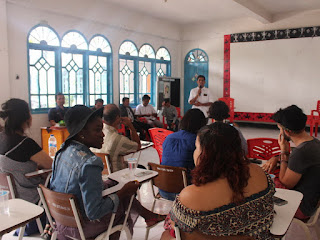 It was a reallygreat opportunity for the participants when they had a chance to meet Gideon Mbiliyora, the regent of East Sumba regency at his official residence. Some topics came up at that moment around the Regent's concern on local young people and potencies of East Sumba. There were also criticisms about waste management scattered in Waingapu Amusement Park (THR) and he stated that he would remind the organizers of the event to prepare additional bins. Then, ‘Terpadu’ Theological Seminary of Waingapu became the next visit and they discussed with the lecturers and students. The students shared their experiences during their activities at Stube-HEMAT Sumba and the lecturers hoped that there would be closer collaboration with Stube-HEMAT Sumba.
It was a reallygreat opportunity for the participants when they had a chance to meet Gideon Mbiliyora, the regent of East Sumba regency at his official residence. Some topics came up at that moment around the Regent's concern on local young people and potencies of East Sumba. There were also criticisms about waste management scattered in Waingapu Amusement Park (THR) and he stated that he would remind the organizers of the event to prepare additional bins. Then, ‘Terpadu’ Theological Seminary of Waingapu became the next visit and they discussed with the lecturers and students. The students shared their experiences during their activities at Stube-HEMAT Sumba and the lecturers hoped that there would be closer collaboration with Stube-HEMAT Sumba.
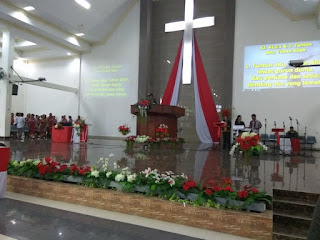 Sunday morning in Sumba was begun with a morning service at GKS Payeti and the participants had asmall choir in Deutsch and Indonesian, before flying to Denpasar, Bali. While traveling in the Legian area, the participants were shocked by a series of earthquakes from big earthquakes of Lombok. The participants and the people became panic, not knowing what was happening. It was a very memorable experience because they felt a big earthquake directly.
Sunday morning in Sumba was begun with a morning service at GKS Payeti and the participants had asmall choir in Deutsch and Indonesian, before flying to Denpasar, Bali. While traveling in the Legian area, the participants were shocked by a series of earthquakes from big earthquakes of Lombok. The participants and the people became panic, not knowing what was happening. It was a very memorable experience because they felt a big earthquake directly.
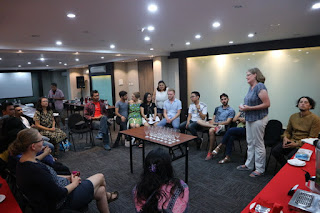 Monday, August 6, 2018 was a farewell event for German-Indonesian Student Exchange 2017/2018. A reflection and sharing of experiences in the form of impressions, feelings, values of life and hope for the future ended a series of events in Indonesia.
Monday, August 6, 2018 was a farewell event for German-Indonesian Student Exchange 2017/2018. A reflection and sharing of experiences in the form of impressions, feelings, values of life and hope for the future ended a series of events in Indonesia.-
Aly Chiman [email protected] comments.
Senin, 24 Desember 2018 at 06:58:53
Hello there,
My name is Aly and I would like to know if you would have any interest to have your website here at or.id promoted as a resource on our blog alychidesign.com ?
We are in the midst of updating our broken link resources to include current and up to date resources for our readers. Our resource links are manually approved allowing us to mark a link as a do-follow link as well
.
If you may be interested please in being included as a resource on our blog, please let me know.
Thanks,
Aly
Yogyakarta and Its Surroundings Germany – Indonesia Exchange 2017/2018 in Yogyakarta
Tuesday, 31 July 2018by adminstube
 On the next day we visited Sultan's Palace of Yogyakarta. Withone tour guide, we went around and witnessed the atmosphere and cultural heritage in the palace. Kanjeng Pangeran Haryo Yudohadiningrat gladly explained the history and philosophy of Javanese culture in Yogyakarta, so participants knew the meaning of place names taken from the imaginary axis of Merapi, Tugu, Kraton, Krapyak, to the Indian Ocean.
On the next day we visited Sultan's Palace of Yogyakarta. Withone tour guide, we went around and witnessed the atmosphere and cultural heritage in the palace. Kanjeng Pangeran Haryo Yudohadiningrat gladly explained the history and philosophy of Javanese culture in Yogyakarta, so participants knew the meaning of place names taken from the imaginary axis of Merapi, Tugu, Kraton, Krapyak, to the Indian Ocean.

 The education dynamics, especially Christian education in the midst of Indonesia's Muslim majority became an interesting thing to discuss, as well as service involvement in health. So, we visited UKDW as one of Christian universities in Yogyakarta and Bethesda Hospital, discussed and observed many challenges and opportunities. The bag industry Dowa empowering andinvolving the surrounding localpeople and women in their bag-making process as an effort to develop society economy became a divergent attraction. No less exciting when we walked through Malioboro and spent time together there.
The education dynamics, especially Christian education in the midst of Indonesia's Muslim majority became an interesting thing to discuss, as well as service involvement in health. So, we visited UKDW as one of Christian universities in Yogyakarta and Bethesda Hospital, discussed and observed many challenges and opportunities. The bag industry Dowa empowering andinvolving the surrounding localpeople and women in their bag-making process as an effort to develop society economy became a divergent attraction. No less exciting when we walked through Malioboro and spent time together there.
Hand in Hand For A Better World Wisma Pojok Indah, 27-29 July 2018
Monday, 30 July 2018by adminstube
 The topic on Western and Eastern Values isinteresting because they came from differentperceptions that develop in their own community. Amalinda Savirani, Ph.D., the chairman of Department of Politics and Government, Faculty of Social and Political Sciences, Postgraduate Program at Gadjah Mada University in Yogyakarta, explained that, in fact the Western and Eastern terms are not necessarily appropriate because the West and East itself are related with previously implantedperceptions and understandings. She also revealed two views about values. First, values are considered natural and they have existed from the beginning. Second, values are maintained and then developed. When someone is born, he/she is already in the environment of values, but it will change graduallyduring the development of age, era and experience. Those make values different in one communitycompared to other communities. Values become local because they develop according to the development of the local community. However, there are universal values that are mutual agreements and must be campaigned continuously, such as humanity, sustainability of life and human welfare.
The topic on Western and Eastern Values isinteresting because they came from differentperceptions that develop in their own community. Amalinda Savirani, Ph.D., the chairman of Department of Politics and Government, Faculty of Social and Political Sciences, Postgraduate Program at Gadjah Mada University in Yogyakarta, explained that, in fact the Western and Eastern terms are not necessarily appropriate because the West and East itself are related with previously implantedperceptions and understandings. She also revealed two views about values. First, values are considered natural and they have existed from the beginning. Second, values are maintained and then developed. When someone is born, he/she is already in the environment of values, but it will change graduallyduring the development of age, era and experience. Those make values different in one communitycompared to other communities. Values become local because they develop according to the development of the local community. However, there are universal values that are mutual agreements and must be campaigned continuously, such as humanity, sustainability of life and human welfare. Four international students shared their experiencesduring the raining. They are; Hannah Eichberg, a German student studying Protestant Theology at University of Hamburg invited participants to reflect back on the attitude of nationalism and love of the country. This is important but not trapped in narrow nationalism; Onno Hofmann, also from Germany and studying at the Protestant Theology, outlined the relation between religion and values in society;then, Prapti Maharjan, a student from Nepal who studied at the Berlin Technical University discussed the issue of oil palm in Indonesia. Palm oil is indeed a prime source of plantations in the Sumatra and Kalimantan regions because it is a source of livelihood for local residents. Then, palm oil is one of the ingredients for making various products known globally. But on the other hand, the rise of palm oil plantations has triggered land clearing that threatens biodiversity, groundwater needs and conflicts over land use. This is a shared thought about palm oil and palm oil, not only thinking about the benefits but the environmental impacts. The lastwas Carlos Tamayo, a Cuban student who is studying economics, reminded of the importance of cross-cultural communication skills in the global era. According to him, this ability is important to be owned by someone because it will help him/her to adapt to new environment, how to behave and take part for responsibilities.
Four international students shared their experiencesduring the raining. They are; Hannah Eichberg, a German student studying Protestant Theology at University of Hamburg invited participants to reflect back on the attitude of nationalism and love of the country. This is important but not trapped in narrow nationalism; Onno Hofmann, also from Germany and studying at the Protestant Theology, outlined the relation between religion and values in society;then, Prapti Maharjan, a student from Nepal who studied at the Berlin Technical University discussed the issue of oil palm in Indonesia. Palm oil is indeed a prime source of plantations in the Sumatra and Kalimantan regions because it is a source of livelihood for local residents. Then, palm oil is one of the ingredients for making various products known globally. But on the other hand, the rise of palm oil plantations has triggered land clearing that threatens biodiversity, groundwater needs and conflicts over land use. This is a shared thought about palm oil and palm oil, not only thinking about the benefits but the environmental impacts. The lastwas Carlos Tamayo, a Cuban student who is studying economics, reminded of the importance of cross-cultural communication skills in the global era. According to him, this ability is important to be owned by someone because it will help him/her to adapt to new environment, how to behave and take part for responsibilities.
First Step in Indonesia:Jakarta
Friday, 27 July 2018by adminstube
 Education services carried out by GKI Pondok Indah through Tirtamarta-BPK Penabur education foundation were the first destination in Jakarta. Here isthe place where Rev. Tumpal serves as a school pastor. Participants got opportunity tohave dialogue with students and teachers andinteracted with the members of church assembly about the challenges of current education services in Indonesia. Character building is the main focus in this school to be implemented beside supporting facilities and extra curricular activities to develop competitive human resources.
Education services carried out by GKI Pondok Indah through Tirtamarta-BPK Penabur education foundation were the first destination in Jakarta. Here isthe place where Rev. Tumpal serves as a school pastor. Participants got opportunity tohave dialogue with students and teachers andinteracted with the members of church assembly about the challenges of current education services in Indonesia. Character building is the main focus in this school to be implemented beside supporting facilities and extra curricular activities to develop competitive human resources. Dialogue with GMKI central board in Jakarta, Sahat MP Sinurat and Alan Christian Singkali, opened up opportunities to get to know eachother of fourorganizations which concerned on youth movement to build the nation and open opportunities for cooperation in the future among ESG, Stube Germany and Stube-HEMAT Indonesia and GMKI.
Dialogue with GMKI central board in Jakarta, Sahat MP Sinurat and Alan Christian Singkali, opened up opportunities to get to know eachother of fourorganizations which concerned on youth movement to build the nation and open opportunities for cooperation in the future among ESG, Stube Germany and Stube-HEMAT Indonesia and GMKI. Knowing Indonesia, democracy and the Indonesian political system became an interesting agenda. The national anthem‘Indonesia Raya’filled the air ofAbdul Muis hall, part of Wisma Nusantara to preceed the meeting. Then, the participants listened the explanation about the steps of policy making, budget allocation, and other topics. In this place participants also visited House of Representative museum to get to know the history and democracy of Indonesia.
Knowing Indonesia, democracy and the Indonesian political system became an interesting agenda. The national anthem‘Indonesia Raya’filled the air ofAbdul Muis hall, part of Wisma Nusantara to preceed the meeting. Then, the participants listened the explanation about the steps of policy making, budget allocation, and other topics. In this place participants also visited House of Representative museum to get to know the history and democracy of Indonesia. The Old City area in North Jakarta and its history were depicted by Pius Ledjap, a local tour guide. Beginning with the story of the existence of 'Engelse Burg', the oldest bridge in Indonesia which was built in 1628, participants began to explore the region. Bahari Museum with various types of traditional boats from Sabang to Merauke, shipping equipment, and various pictures relating to shipping; Syahbandar Tower, a tower to watch the vessels at Batavia port; the area of the old city and the Fatahillah square are currently growing into a public space and be preserved by its environment and architecture of the building.
The Old City area in North Jakarta and its history were depicted by Pius Ledjap, a local tour guide. Beginning with the story of the existence of 'Engelse Burg', the oldest bridge in Indonesia which was built in 1628, participants began to explore the region. Bahari Museum with various types of traditional boats from Sabang to Merauke, shipping equipment, and various pictures relating to shipping; Syahbandar Tower, a tower to watch the vessels at Batavia port; the area of the old city and the Fatahillah square are currently growing into a public space and be preserved by its environment and architecture of the building. The traffic jam in Jakarta became a real experience of the participants when visiting Setu Babakan, Betawinese Cultural Village in Srengseng Sawah, South Jakarta. "This area become the pioneer of the Betawinese Culture preservation center which include documentation of cultural literatures, tools relating to the tradition, typical building architecture, typical foods and flora commonly found here", said Kang Indra, a local facilitator, originated to Betawinese ethnic. Participants also made happily their own egg crust, one of the typical Betawinese ethnic foods, called ‘kerak telor’.
The traffic jam in Jakarta became a real experience of the participants when visiting Setu Babakan, Betawinese Cultural Village in Srengseng Sawah, South Jakarta. "This area become the pioneer of the Betawinese Culture preservation center which include documentation of cultural literatures, tools relating to the tradition, typical building architecture, typical foods and flora commonly found here", said Kang Indra, a local facilitator, originated to Betawinese ethnic. Participants also made happily their own egg crust, one of the typical Betawinese ethnic foods, called ‘kerak telor’.
“Studying Abroad: Why Not?”
Monday, 9 July 2018by adminstube
 On Saturday, July 7, 2018, Stube-HEMAT Yogyakarta felt so proud when Julianti Marbun, M.Si., alumny of Stube, who iscurrently teaching at Nusa Cendana University, Kupang, and her colleague, Tanda Soalagogo Sirait, M.Sc, alumni of University of Canberra, Australia visited Stube. Tanda continuedhis study on Regional and city planning, focusing on development in urban areas, through scholarships from Australian government. This discussion was attended by 13 students from various study backgrounds, regions and campuses in Yogyakarta.
On Saturday, July 7, 2018, Stube-HEMAT Yogyakarta felt so proud when Julianti Marbun, M.Si., alumny of Stube, who iscurrently teaching at Nusa Cendana University, Kupang, and her colleague, Tanda Soalagogo Sirait, M.Sc, alumni of University of Canberra, Australia visited Stube. Tanda continuedhis study on Regional and city planning, focusing on development in urban areas, through scholarships from Australian government. This discussion was attended by 13 students from various study backgrounds, regions and campuses in Yogyakarta.Come, See, Practice and I Can! Follow-up group of NTT students
Friday, 25 May 2018by adminstube
 Human have thought and curiosity, so they will try to find out answers of questionsbothering their mind until the answers are gained. Feeling of curiousity also covered theparticipants’ mind of Stube-HEMAT Yogyakarta after Organic Farming training held on May 4-6, 2018, especially when they followed a session delivered by TO Suprapto, one of the facilitatorsexplaining about an integrated agriculture systemand the utilization of local materials for liquid fertilizer.
Human have thought and curiosity, so they will try to find out answers of questionsbothering their mind until the answers are gained. Feeling of curiousity also covered theparticipants’ mind of Stube-HEMAT Yogyakarta after Organic Farming training held on May 4-6, 2018, especially when they followed a session delivered by TO Suprapto, one of the facilitatorsexplaining about an integrated agriculture systemand the utilization of local materials for liquid fertilizer. The ingredients of liquid fertilizer are 20 liters ofcow urine, 2 kilograms of herbal substances called ‘empon-empon’, someotten fruits, 1 liter of molasses, 2 kgs guano kohe, gamal leaves and banana stems. The following is the way how to make it: ‘empon-empon’ are sliced ??and boiled, after boiling, the ingredients are cooled and mixed with cow urine, molasses, rotten fruits, gamal leaves, and chopped banana stems. The mixture were put in a bucket and sealed for about two weeks forfermentation. After two weeks, the liquid fertilizer is completed and ready to use. If there is no cow urine, coconut water can be used instead, and mollases can be replaced with brown sugar. Liquid fertilizer is useful to increase soil nutrition because it contains organic nutrients to refresh plants. Other benefit of using ‘empon-empon’ iskilling pests in the soil because it tends to heat.
The ingredients of liquid fertilizer are 20 liters ofcow urine, 2 kilograms of herbal substances called ‘empon-empon’, someotten fruits, 1 liter of molasses, 2 kgs guano kohe, gamal leaves and banana stems. The following is the way how to make it: ‘empon-empon’ are sliced ??and boiled, after boiling, the ingredients are cooled and mixed with cow urine, molasses, rotten fruits, gamal leaves, and chopped banana stems. The mixture were put in a bucket and sealed for about two weeks forfermentation. After two weeks, the liquid fertilizer is completed and ready to use. If there is no cow urine, coconut water can be used instead, and mollases can be replaced with brown sugar. Liquid fertilizer is useful to increase soil nutrition because it contains organic nutrients to refresh plants. Other benefit of using ‘empon-empon’ iskilling pests in the soil because it tends to heat.
Halmahera Coconut: The Ignored Potency
Tuesday, 15 May 2018by adminstube
How Is Our Food Bank?
Tuesday, 8 May 2018by adminstube
 The three-day and two-night training, from 4 to 6 May 2018 at Camelia guesthouse, Kaliurang, presents T.O. Suprapto, an organic farmer from Joglo Tani Yogyakarta, which presents the bases of organic agriculture by emphasizing 'eat what we plant, plant what we eat', so we can achieve food self-sufficiency while also consuming healthy organic food. T.O. Suprapto also provides study opportunities for every youth who is financially limited, to continue their study in college, noting that they must be majoring in agriculture.
The three-day and two-night training, from 4 to 6 May 2018 at Camelia guesthouse, Kaliurang, presents T.O. Suprapto, an organic farmer from Joglo Tani Yogyakarta, which presents the bases of organic agriculture by emphasizing 'eat what we plant, plant what we eat', so we can achieve food self-sufficiency while also consuming healthy organic food. T.O. Suprapto also provides study opportunities for every youth who is financially limited, to continue their study in college, noting that they must be majoring in agriculture. In order that the participants have the capability to perform risk and potency mapping in their neighborhood, Dr. F. Didiet Heru Swasono, M.P., a lecturer from the Faculty of Agro Technology at Mercu Buana University conveys about the importance of organic certification as a form of consumer protection standard which is based on ministerial regulation and Indonesian national standard. He also speaks about the necessity for socio-cultural and environmental mapping skills for the participants to have in their neighborhood.
In order that the participants have the capability to perform risk and potency mapping in their neighborhood, Dr. F. Didiet Heru Swasono, M.P., a lecturer from the Faculty of Agro Technology at Mercu Buana University conveys about the importance of organic certification as a form of consumer protection standard which is based on ministerial regulation and Indonesian national standard. He also speaks about the necessity for socio-cultural and environmental mapping skills for the participants to have in their neighborhood. To parallelize the theory and the practice, on the second day, all participants did an exposure to two places; one is the "Bumi Lestari" Female Farmer Group in Sembung village, Purwobinangun, Pakem, and the second being "Kuncup" organic farm managed by Dedy Tri Kuncoro. Both of these places are a representation of organic farming that has been running and even innovating in the manufacturing of fertilizer. "Bumi Lestari" itself is one of the multiple sites of Lumbung Mataraman initiated by Sri Sultan HB X.
To parallelize the theory and the practice, on the second day, all participants did an exposure to two places; one is the "Bumi Lestari" Female Farmer Group in Sembung village, Purwobinangun, Pakem, and the second being "Kuncup" organic farm managed by Dedy Tri Kuncoro. Both of these places are a representation of organic farming that has been running and even innovating in the manufacturing of fertilizer. "Bumi Lestari" itself is one of the multiple sites of Lumbung Mataraman initiated by Sri Sultan HB X. Meanwhile, "Kuncup" organic farm developed tabulampot (fruit plant in a pot) which has been marketed outside of the province. Here the participants are interested in the utilization of egg waste as a material for making organic fertilizer.
Meanwhile, "Kuncup" organic farm developed tabulampot (fruit plant in a pot) which has been marketed outside of the province. Here the participants are interested in the utilization of egg waste as a material for making organic fertilizer.
 Discussing agricultural topics will always link back to the economy and politics of the nation. Back then when Indonesia was imagined to achieve rice self-sufficiency, it opened the floodgate for the arrival of various types of chemical fertilizer for the so-called "Green Revolution". Now, Rahmat Jabaril (artist and Dago Pojok creative village's figure), Eko Prasetyo (Social Movement Institute) and Paguyuban Petani Organik Jodhog, complete the discourse on the issues of independence, creativity, land takeover, the challenge of Indonesian farmers, and social welfare.
Discussing agricultural topics will always link back to the economy and politics of the nation. Back then when Indonesia was imagined to achieve rice self-sufficiency, it opened the floodgate for the arrival of various types of chemical fertilizer for the so-called "Green Revolution". Now, Rahmat Jabaril (artist and Dago Pojok creative village's figure), Eko Prasetyo (Social Movement Institute) and Paguyuban Petani Organik Jodhog, complete the discourse on the issues of independence, creativity, land takeover, the challenge of Indonesian farmers, and social welfare. Twenty-seven participants are eager to follow the three-day training and planning to do follow-ups, such as bringing new communities to the farmer's community, further study on the use of coconut, promoting food and organic farming in social media, growing organic herbs and learning to make organic pesticide.
Twenty-seven participants are eager to follow the three-day training and planning to do follow-ups, such as bringing new communities to the farmer's community, further study on the use of coconut, promoting food and organic farming in social media, growing organic herbs and learning to make organic pesticide.
 Everyone is entitled to a decent and healthy life. Especially, a healthy and decent life coupled with a healthy and balanced lifestyle and mindset. Thus,as the nation's youth, we must implement healthy living so we can become an agent of change and able to give birth to a generation which is healthier, smarter, decent living, and even independence on their own homeland. (SAP).
Everyone is entitled to a decent and healthy life. Especially, a healthy and decent life coupled with a healthy and balanced lifestyle and mindset. Thus,as the nation's youth, we must implement healthy living so we can become an agent of change and able to give birth to a generation which is healthier, smarter, decent living, and even independence on their own homeland. (SAP).Young People Promote Human Rights
Saturday, 5 May 2018by adminstube
Started From Mental
Monday, 16 April 2018by adminstube
 Stube-HEMAT Yogyakarta as a student mentoring institution see the importance of young generation especially students to understand, realize and involve in the surrounding agricultural issues. Therefore on April 14, 2018, taken place in Omah Cengkir, at 10.00 AM- 14.20 PM, an initial discussion related to organic farming was held and it was continued with an exposure activity to organic farm in Pakem. This discussion invited Y.B. Cahya Widiyanto, M.Si., Ph.D., a lecturer of Psychology at Sanata Dharma University and Antoni Kusuma Wardhana, S.Psi., M.M.,a practitioner and activist of marketing for organic agricultural products.
Stube-HEMAT Yogyakarta as a student mentoring institution see the importance of young generation especially students to understand, realize and involve in the surrounding agricultural issues. Therefore on April 14, 2018, taken place in Omah Cengkir, at 10.00 AM- 14.20 PM, an initial discussion related to organic farming was held and it was continued with an exposure activity to organic farm in Pakem. This discussion invited Y.B. Cahya Widiyanto, M.Si., Ph.D., a lecturer of Psychology at Sanata Dharma University and Antoni Kusuma Wardhana, S.Psi., M.M.,a practitioner and activist of marketing for organic agricultural products. Mr. Cahya, known as Mr. Johan, focused more on directing the participants to improve their mental and mindset in order to build organic mentality having concern on nature and long-term thinking, not just short term thinking because organic farming is a long process of how human becomes aware andconcerned of nature and health.
Mr. Cahya, known as Mr. Johan, focused more on directing the participants to improve their mental and mindset in order to build organic mentality having concern on nature and long-term thinking, not just short term thinking because organic farming is a long process of how human becomes aware andconcerned of nature and health.
 Next, Mr. Dhana delivered his session to open the participants' insight how to offer organic products more interesting through an innovation touch in order to be moremarket-acceptable. "Actually catching opportunities in the agricultural sector is not difficult, but it can not be said to be easy as well. Keep trying and doing innovation are the key to have successful results", he explained.
Next, Mr. Dhana delivered his session to open the participants' insight how to offer organic products more interesting through an innovation touch in order to be moremarket-acceptable. "Actually catching opportunities in the agricultural sector is not difficult, but it can not be said to be easy as well. Keep trying and doing innovation are the key to have successful results", he explained.
 "I used to manage work from up to downstream by myself and I found out it failed. So what I do next is focus on one field, that is, organic products marketing.Let farmers plant because they understand more better about it and let the chef to cook the material to be a unique dish”, he stated.
"I used to manage work from up to downstream by myself and I found out it failed. So what I do next is focus on one field, that is, organic products marketing.Let farmers plant because they understand more better about it and let the chef to cook the material to be a unique dish”, he stated.
 After the discussion, the participants observed an organic farmland managed by Dhana. The owner of organic farm, Ari explained that this organic farming started from land management, land preparation, water management and finally process toobtain organic certificates.
After the discussion, the participants observed an organic farmland managed by Dhana. The owner of organic farm, Ari explained that this organic farming started from land management, land preparation, water management and finally process toobtain organic certificates.
10 Ideas to Answer Reality
Monday, 19 March 2018by adminstube
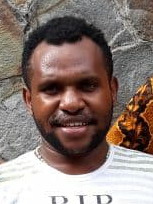 A student from Dogiyai, Papua studying in Civil Engineering, Janabadra University. "In my area there is still a big allurement to play gambling, and degenerated habit by littering trash in drainage and living unhealthy. These things are not good and I want to make the community awarehow to maintain the environment by cleaning the drainage channels regularly, cultivating fields better, so that, the harvest increasing,next the harvests can be consumed by themselves and for sale, also to educate society about product expiry date. I hope they will get new understanding about economic condition andenvironment so the society will get better.Finally, the improvement of economic and social condition will reduce social problems of my local area ".
A student from Dogiyai, Papua studying in Civil Engineering, Janabadra University. "In my area there is still a big allurement to play gambling, and degenerated habit by littering trash in drainage and living unhealthy. These things are not good and I want to make the community awarehow to maintain the environment by cleaning the drainage channels regularly, cultivating fields better, so that, the harvest increasing,next the harvests can be consumed by themselves and for sale, also to educate society about product expiry date. I hope they will get new understanding about economic condition andenvironment so the society will get better.Finally, the improvement of economic and social condition will reduce social problems of my local area ".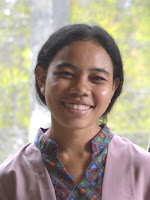 A young girl from Kakaniuk village,Central Malaka, Malaka, East Nusa Tenggara, studying in Environmental Engineering, Institut Teknologi Yogyakarta (ITY). "Central Malaka area consists of medium plains (270-537 masl) and most of the people are farmers, others are Civil officials, police, private and others. There is an anecdote from in my village saying, no matter how high your education is and wherever you are working, finally you will back to grab a machete and a tugtoo for working in the field. "
A young girl from Kakaniuk village,Central Malaka, Malaka, East Nusa Tenggara, studying in Environmental Engineering, Institut Teknologi Yogyakarta (ITY). "Central Malaka area consists of medium plains (270-537 masl) and most of the people are farmers, others are Civil officials, police, private and others. There is an anecdote from in my village saying, no matter how high your education is and wherever you are working, finally you will back to grab a machete and a tugtoo for working in the field. "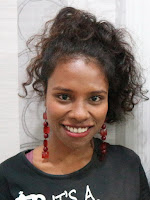 She is studying English Education, Sarjanawiyata Tamansiswa University and originated from Aru Islands, Maluku. "I am interested in many sharings related to cross-culture understanding and positive mind-set. This idea is driven from misunderstanding of dressing style and culture in certain areas. Let's fix our 'mindset' by not saying 'this is wrong' or 'that's right', 'this is proper' and 'it is not appropriate' but think positively that different regions mean different cultures. One’s self-confidence is growing from family and environment for us to grow".
She is studying English Education, Sarjanawiyata Tamansiswa University and originated from Aru Islands, Maluku. "I am interested in many sharings related to cross-culture understanding and positive mind-set. This idea is driven from misunderstanding of dressing style and culture in certain areas. Let's fix our 'mindset' by not saying 'this is wrong' or 'that's right', 'this is proper' and 'it is not appropriate' but think positively that different regions mean different cultures. One’s self-confidence is growing from family and environment for us to grow".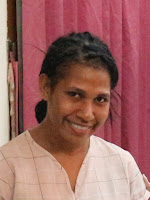 "I study at Janabadra University majoring in Accounting, originally from Mare, Maybrat, Sorong, West Papua. In this Spirituality training I got a description of the direction of Indonesian economy in the future,in which internet plays an importantrole in many things, one of them is business and economy. I thought about my region that already has internet access, but the people there do not utilize it optimally, just to access social media and other sites, post photos, status even porn sites. Internet users are dominated by children whose parents have no ideasabout internet."
"I study at Janabadra University majoring in Accounting, originally from Mare, Maybrat, Sorong, West Papua. In this Spirituality training I got a description of the direction of Indonesian economy in the future,in which internet plays an importantrole in many things, one of them is business and economy. I thought about my region that already has internet access, but the people there do not utilize it optimally, just to access social media and other sites, post photos, status even porn sites. Internet users are dominated by children whose parents have no ideasabout internet."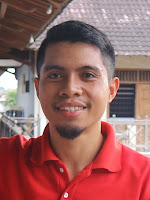 "I am from Waingapu, East Sumba, East Nusa Tenggara and studying Magister of Foresty in Gadjah Mada University. Formerly, the economic value of goods are still low becausemany of them are available in nature, but now the value is getting higher because the availability of nature is decreasing. Economic interests become priority than spiritual, social and environment. In addition, the low human resources impact on low creativity and competitiveness. Sometimes economic demands push criminality rate to increase". "Spiritual and economic balance need to be realized because spirituality is a relationship between human and God embodied in daily life, such as provide physical needs and interaction with others and environment. I have some ideas, first,giving attention to spirituality education since children. Second, increasing awareness of faith, relationships among people and participation in community organization. Third, improving quality of human resources to utilize natural resources wisely, and fourth, training people with skills and knowledge about regional-based potency, such as agriculture, livestock and traditional culture in Sumba as tourism opportunity in Sumba".
"I am from Waingapu, East Sumba, East Nusa Tenggara and studying Magister of Foresty in Gadjah Mada University. Formerly, the economic value of goods are still low becausemany of them are available in nature, but now the value is getting higher because the availability of nature is decreasing. Economic interests become priority than spiritual, social and environment. In addition, the low human resources impact on low creativity and competitiveness. Sometimes economic demands push criminality rate to increase". "Spiritual and economic balance need to be realized because spirituality is a relationship between human and God embodied in daily life, such as provide physical needs and interaction with others and environment. I have some ideas, first,giving attention to spirituality education since children. Second, increasing awareness of faith, relationships among people and participation in community organization. Third, improving quality of human resources to utilize natural resources wisely, and fourth, training people with skills and knowledge about regional-based potency, such as agriculture, livestock and traditional culture in Sumba as tourism opportunity in Sumba".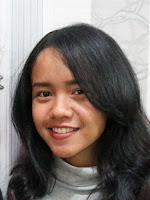 "I live in Sleman, Special Region of Yogyakarta and study at Sanata Dharma University majoring in English Literature. I found problems around me, such as the lack of community knowledge about the benefits of smartphone to increase revenue. Some adults and elderly people use smartphone just for chatting on social media, like Whatsapp, not getting any other benefits. Some of them know the benefits but unable to use smartphone for business". "So, I want to share with people around me about digital economy and its importance, help them find ideas for commercial products, and help them to know the way to operate smartphone to support business."
"I live in Sleman, Special Region of Yogyakarta and study at Sanata Dharma University majoring in English Literature. I found problems around me, such as the lack of community knowledge about the benefits of smartphone to increase revenue. Some adults and elderly people use smartphone just for chatting on social media, like Whatsapp, not getting any other benefits. Some of them know the benefits but unable to use smartphone for business". "So, I want to share with people around me about digital economy and its importance, help them find ideas for commercial products, and help them to know the way to operate smartphone to support business."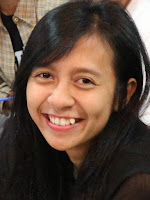 from Solo Central Java, a Psychology student at Sanata Dharma University. "After attending Spirituality training, I mapped out actual social situation around me and found unemployed educated people, whereas, many companies open widely for job vacancies. What is wrong with this situation? Actualy, well-educated people should have ability for working, good integrity, and company should not lack of workers. In addition, children have rights for getting proper education, because the personality of nation is formed since children. The ideas that came up in my mind are, first, gather the unemployed people and give enlightenment to them about jobs, talent and interest, also how to develop. Second, do socialization on importance of children’ character and personality, instilling good character and personality to children, through church Sunday school, for one example".
from Solo Central Java, a Psychology student at Sanata Dharma University. "After attending Spirituality training, I mapped out actual social situation around me and found unemployed educated people, whereas, many companies open widely for job vacancies. What is wrong with this situation? Actualy, well-educated people should have ability for working, good integrity, and company should not lack of workers. In addition, children have rights for getting proper education, because the personality of nation is formed since children. The ideas that came up in my mind are, first, gather the unemployed people and give enlightenment to them about jobs, talent and interest, also how to develop. Second, do socialization on importance of children’ character and personality, instilling good character and personality to children, through church Sunday school, for one example". "The understanding I got from Spirituality training held by Stube-HEMAT Yogyakarta is getting broader perspective toward Sumba. This is important because I study Government Science at STPMD APMD Yogyakarta. We all know that Sumba is growing to develop in many sectors includingregional development, tourism, trade, education and technology. But the question is whether the community is ready with the development, what kind of community participation in the development and how far is the development bringsbenefit to the community. Therefore, there are emerging ideas that can be done in my village in Kahaungu Eti, East Sumba, such as the need to have dialogue between government and community about development goals, explore benefits and impacts of development that will be done, the need for the community to maintain local wisdom of the local people, and involvement of youth generation in development planning and implementation ".
"The understanding I got from Spirituality training held by Stube-HEMAT Yogyakarta is getting broader perspective toward Sumba. This is important because I study Government Science at STPMD APMD Yogyakarta. We all know that Sumba is growing to develop in many sectors includingregional development, tourism, trade, education and technology. But the question is whether the community is ready with the development, what kind of community participation in the development and how far is the development bringsbenefit to the community. Therefore, there are emerging ideas that can be done in my village in Kahaungu Eti, East Sumba, such as the need to have dialogue between government and community about development goals, explore benefits and impacts of development that will be done, the need for the community to maintain local wisdom of the local people, and involvement of youth generation in development planning and implementation ".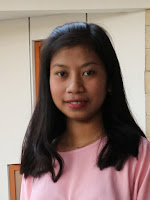 "The problems and social situation occurring in my area, Tabundung, East Sumba, NTT are lack of wetland agriculture, irrigation system, agriculture land and government attention to agriculture. This Spirituality training motivates me to do something for my village, toshare ideas to farmers of using organic materials, using natural fertilizers and eradicating pests without chemical pesticides but natural materials instead. I have told this to my parents and they responded well. Then propose to government to build irrigation for agriculture".
"The problems and social situation occurring in my area, Tabundung, East Sumba, NTT are lack of wetland agriculture, irrigation system, agriculture land and government attention to agriculture. This Spirituality training motivates me to do something for my village, toshare ideas to farmers of using organic materials, using natural fertilizers and eradicating pests without chemical pesticides but natural materials instead. I have told this to my parents and they responded well. Then propose to government to build irrigation for agriculture". "I am from Kefamenanu, Timor Tengah Utara, Nusa Tenggara Timur and studying Hospital Management at STIE IEU. I found enlightenment after attending Spirituality training by Stube-HEMAT Yogyakarta and my mind was open that spirituality should be manifested into action. I was facilitated to see the reality occurred in my village, Amarasi, Kupang, NTT whichstill faces water shortage during dry season and people give less attention to health condition. They have to walk for kilometers to get water using Jerri cans to drink and cook".
"I am from Kefamenanu, Timor Tengah Utara, Nusa Tenggara Timur and studying Hospital Management at STIE IEU. I found enlightenment after attending Spirituality training by Stube-HEMAT Yogyakarta and my mind was open that spirituality should be manifested into action. I was facilitated to see the reality occurred in my village, Amarasi, Kupang, NTT whichstill faces water shortage during dry season and people give less attention to health condition. They have to walk for kilometers to get water using Jerri cans to drink and cook".Spirituality: The Contribution of Christian Ethics in Economy
Monday, 26 February 2018by adminstube
 Several experienced persons in their field facilitated the training, such as Ariani Narwatujati, S.S., M.Pd., Director of Stube-HEMAT challenged participants to improve their quality to compete in international level, then Dr. Murti Lestari, M.Si, a lecturer at Economics Faculty of Duta Wacana Christian University (UKDW) revealed the significant economydevelopment bringing to digital economy. Technologyis not only for information systems but also a platform for economy activity, trade, payment and other fields. Today most people can access thedigital economy and utilize it. The mastery of knowledge and technology will be the basis for the development of digital economy that will increaseaffectivity and prosperity. However, people must be wary against technology-based crime.
Several experienced persons in their field facilitated the training, such as Ariani Narwatujati, S.S., M.Pd., Director of Stube-HEMAT challenged participants to improve their quality to compete in international level, then Dr. Murti Lestari, M.Si, a lecturer at Economics Faculty of Duta Wacana Christian University (UKDW) revealed the significant economydevelopment bringing to digital economy. Technologyis not only for information systems but also a platform for economy activity, trade, payment and other fields. Today most people can access thedigital economy and utilize it. The mastery of knowledge and technology will be the basis for the development of digital economy that will increaseaffectivity and prosperity. However, people must be wary against technology-based crime.

 Then, the participants divided themselves into three groups to explore alternative economic systems. Group one made discussion with Sudarwanto, one of managers at Credit Union‘Cindelaras Tumangkar’ to learn financial cooperation and community empowerment. Group two explored ‘Sharia’cooperation with Iwa Khairuttaqwa, head of ‘Shariah’Cooperation at Tamwil Muhammadiyah Agency (BTM) Surya, and group three dialogued with Rev. Harjono and organic farmers in Jodhog, Bantul who had a vision to be dignified farmer through organic farming, restoring rice fields, providing healthy food for the family, having self-reliance in seeds &fertilizer and having marketing harvest andmaintaining interfaith brotherhood.
Then, the participants divided themselves into three groups to explore alternative economic systems. Group one made discussion with Sudarwanto, one of managers at Credit Union‘Cindelaras Tumangkar’ to learn financial cooperation and community empowerment. Group two explored ‘Sharia’cooperation with Iwa Khairuttaqwa, head of ‘Shariah’Cooperation at Tamwil Muhammadiyah Agency (BTM) Surya, and group three dialogued with Rev. Harjono and organic farmers in Jodhog, Bantul who had a vision to be dignified farmer through organic farming, restoring rice fields, providing healthy food for the family, having self-reliance in seeds &fertilizer and having marketing harvest andmaintaining interfaith brotherhood. Participants’ insight on ethicswas growing betterwith the presence of business practitioners, drg. Pipin Ikawati (Fresh Dental), Daniel D. Nugraha (DN rental heavy equipment) and D. Sugiarto (Tosan Offset), who opened the rigors of business world to face challenges and competition, but they kept doing their business with discipline, learning and growing, trusting a work team andpaying attention to employees and consumers' condition.
Participants’ insight on ethicswas growing betterwith the presence of business practitioners, drg. Pipin Ikawati (Fresh Dental), Daniel D. Nugraha (DN rental heavy equipment) and D. Sugiarto (Tosan Offset), who opened the rigors of business world to face challenges and competition, but they kept doing their business with discipline, learning and growing, trusting a work team andpaying attention to employees and consumers' condition.
Jogjakarta & Its Changes
Tuesday, 20 February 2018by adminstube
 In that occasion Selo Soemardjan’s book entitled “Perubahan Sosial di Yogyakarta” become the discussion topic. Held on February 19th 2018, at Toga Mas Bookstore, Gejayan, Yogyakarta, this program presented some speakers, Eko Prasetyo (initiator of SMI), Elanto Wijoyono (from Warga Berdaya Yogyakarta Community), Anna Marsiana (Organization Development Consultant at CSS BfdW), and Hening Wikan (Student of Social-Politic Faculty of UGM) as the moderator.
In that occasion Selo Soemardjan’s book entitled “Perubahan Sosial di Yogyakarta” become the discussion topic. Held on February 19th 2018, at Toga Mas Bookstore, Gejayan, Yogyakarta, this program presented some speakers, Eko Prasetyo (initiator of SMI), Elanto Wijoyono (from Warga Berdaya Yogyakarta Community), Anna Marsiana (Organization Development Consultant at CSS BfdW), and Hening Wikan (Student of Social-Politic Faculty of UGM) as the moderator. Elanto explained that changes in Yogyakarta can be seen from any points of view, and it still becomes a question nowadays, whether those changes already happened in Yogyakarta after era of revolution or not as written in the book. It hasn’t any definite answer until now.
Elanto explained that changes in Yogyakarta can be seen from any points of view, and it still becomes a question nowadays, whether those changes already happened in Yogyakarta after era of revolution or not as written in the book. It hasn’t any definite answer until now. According to Anna Marsiana, Yogyakarta isn’t only a city but also a dynamic process, gathering place of any aspects, any different kinds of society’s element. There are 3 aspects that must be highlighted to see the changes, they are (1) historical aspect, (2) Society movement map respond to faster dynamic, and (3) the function of each person.
According to Anna Marsiana, Yogyakarta isn’t only a city but also a dynamic process, gathering place of any aspects, any different kinds of society’s element. There are 3 aspects that must be highlighted to see the changes, they are (1) historical aspect, (2) Society movement map respond to faster dynamic, and (3) the function of each person. At this occasion, Eko Prasetyo described the process of social changes after colonialism and Left Movement. At that time, the success of social revolution’s ideas is very in demand. It was also a phenomenon that three exist big political parties at that time were dominated by Left Movement. Observing the last parts of Selo Soemardjan’s book, one will find many theoretical advices. They declared that social changes process occurred because of outside stimulant change. When capitalism community comes and they don’t want to obey the prevailing system, they are the one that bring social changes in Yogyakarta. It triggers an extreme social gap in Yogyakarta.
At this occasion, Eko Prasetyo described the process of social changes after colonialism and Left Movement. At that time, the success of social revolution’s ideas is very in demand. It was also a phenomenon that three exist big political parties at that time were dominated by Left Movement. Observing the last parts of Selo Soemardjan’s book, one will find many theoretical advices. They declared that social changes process occurred because of outside stimulant change. When capitalism community comes and they don’t want to obey the prevailing system, they are the one that bring social changes in Yogyakarta. It triggers an extreme social gap in Yogyakarta. Based on those questions, Elanto said that village authority nowadays is no longer traditional, but it has been rational, however some changes are planned and some others are unplanned. Ana responded those questions by stating that traditional system is no longer the main reference because village regulations open opportunities for all of citizens to give ideas and opinions, so those changes may be monitored and planned.
Based on those questions, Elanto said that village authority nowadays is no longer traditional, but it has been rational, however some changes are planned and some others are unplanned. Ana responded those questions by stating that traditional system is no longer the main reference because village regulations open opportunities for all of citizens to give ideas and opinions, so those changes may be monitored and planned.A Collaboration to Fight for Human Rights Launching of Amnesty Indonesia, network hearing and joint meeting
Thursday, 25 January 2018by adminstube
One Leap to Learn Diversity With Amartya Playgroup and Kindergarten
Wednesday, 17 January 2018by adminstube
 Stube-HEMAT Yogyakarta as an institution mentoring studentsstudying in Yogyakarta from various regions in Indonesia,supported the initiative of introducing diversity and fostering tolerance in Indonesia with its diverse culture, religion and language, especially since early age children through a real interaction or ‘experiential learning' on diversities.
Stube-HEMAT Yogyakarta as an institution mentoring studentsstudying in Yogyakarta from various regions in Indonesia,supported the initiative of introducing diversity and fostering tolerance in Indonesia with its diverse culture, religion and language, especially since early age children through a real interaction or ‘experiential learning' on diversities. "I responded well and appreciated the visit by KB/TK Amartya because it will open the children's perspectives to live in religious tolerance. In addition, I saw good response from the teachers to establish togetherness, "said Rev. Hendra Kurniawan, S.Si.
"I responded well and appreciated the visit by KB/TK Amartya because it will open the children's perspectives to live in religious tolerance. In addition, I saw good response from the teachers to establish togetherness, "said Rev. Hendra Kurniawan, S.Si.
Effective Time Management Ready for Final Exam
Monday, 8 January 2018by adminstube
 There were thirty-three students and five teachers following the briefing that was split into several sessions. Stube-HEMAT Yogyakarta, as a student and youth facilitator was invited to be one of facilitators. Stube sent Trustha Rembaka and Sarloce Apang to guide the session on Friday, January 5, 2018.
There were thirty-three students and five teachers following the briefing that was split into several sessions. Stube-HEMAT Yogyakarta, as a student and youth facilitator was invited to be one of facilitators. Stube sent Trustha Rembaka and Sarloce Apang to guide the session on Friday, January 5, 2018. At the end of the session participants were divided into eleven groups. They talked and shared what challenging subjects for them in the exam. Most students expressed difficulties in Mathematics and English. Mathematics is still difficult to understand because the method of teaching is difficult to be understood. In the sharing time, the participants were more open and talked enthusiastically, even their teachers were involved in the conversation.
At the end of the session participants were divided into eleven groups. They talked and shared what challenging subjects for them in the exam. Most students expressed difficulties in Mathematics and English. Mathematics is still difficult to understand because the method of teaching is difficult to be understood. In the sharing time, the participants were more open and talked enthusiastically, even their teachers were involved in the conversation. Trustha reiterated that a wish will come true if there is an action and sincerity to live it. So, from now, use the available study time before exam as well as they can. A big hope that all students can be ready for the exam, can do the exam well, and can pass it together. The session was closed by having a photo together. (SAP).
Trustha reiterated that a wish will come true if there is an action and sincerity to live it. So, from now, use the available study time before exam as well as they can. A big hope that all students can be ready for the exam, can do the exam well, and can pass it together. The session was closed by having a photo together. (SAP).
Developing Interaction and Strengthening Motivation A meet-up with Nancy and Anne
Saturday, 6 January 2018by adminstube
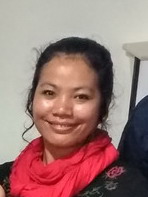 Formerly Nancy got information about Stube Indonesia from her colleague in Cologne that there is a Stube in Indonesia, so she and Anne wanted to know more about it. After having several contacts via email, finally the meeting took place on Friday, January 5, 2018 at Stube-HEMAT Yogyakarta secretariat and it wasattended by fifteen students.
Formerly Nancy got information about Stube Indonesia from her colleague in Cologne that there is a Stube in Indonesia, so she and Anne wanted to know more about it. After having several contacts via email, finally the meeting took place on Friday, January 5, 2018 at Stube-HEMAT Yogyakarta secretariat and it wasattended by fifteen students.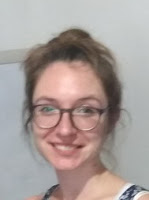 While Anne said that this is her first visit to Indonesia and shefeels grateful to meet friendly students in Indonesia. She conveyedthat the study of social workers covering various areas of action and equipped with intensive theory and practice. This topic learned world of social workers, professions and ethics of social workers, the history of social workers, social and political systems in Germany and the scope of work for social workers. By completing this course the students gain foundation for graduate master's program. They both chose this course because graduated students have a wide scope of work, not only in government agencies or departments but also in non-government organizations even in private companies.
While Anne said that this is her first visit to Indonesia and shefeels grateful to meet friendly students in Indonesia. She conveyedthat the study of social workers covering various areas of action and equipped with intensive theory and practice. This topic learned world of social workers, professions and ethics of social workers, the history of social workers, social and political systems in Germany and the scope of work for social workers. By completing this course the students gain foundation for graduate master's program. They both chose this course because graduated students have a wide scope of work, not only in government agencies or departments but also in non-government organizations even in private companies.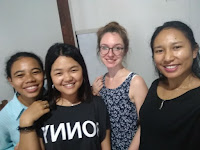
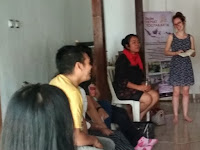 Stube-HEMAT Yogyakarta students enthusiastically responded to Nancy and Anne and asked questions such as how to become a participant of the German Aupair program. There are two ways to join the program, first, personally, where the aplicants register online and must provide some money as guarantee or family in Germany, or second, via agent in whichapplicants apply through by dealing with different cost. Next question wants to know whether Nancywill return back to Indonesia after graduation. She declared that she did not know the time when she will return to Indonesia. In additional, Anne also revealed her reason to enter the college because she liked to interact and help others.
Stube-HEMAT Yogyakarta students enthusiastically responded to Nancy and Anne and asked questions such as how to become a participant of the German Aupair program. There are two ways to join the program, first, personally, where the aplicants register online and must provide some money as guarantee or family in Germany, or second, via agent in whichapplicants apply through by dealing with different cost. Next question wants to know whether Nancywill return back to Indonesia after graduation. She declared that she did not know the time when she will return to Indonesia. In additional, Anne also revealed her reason to enter the college because she liked to interact and help others.Web Archive
2025 (17)Total: 485
Youtube Channel
Lebih baik diam dari pada Berbicara Tetapi tidak ada Yang Di pentingkan Dalam Bicaranya
-->








